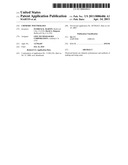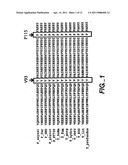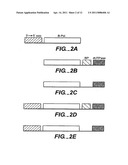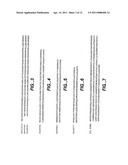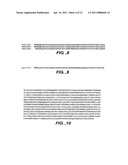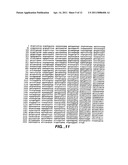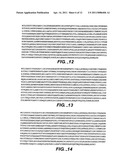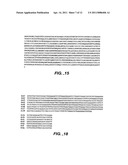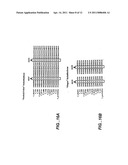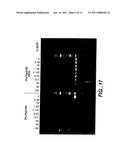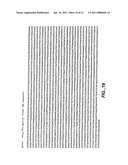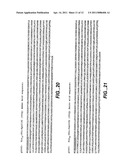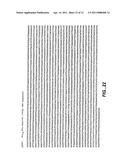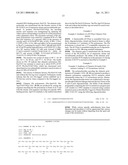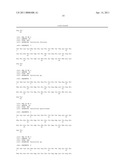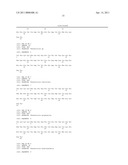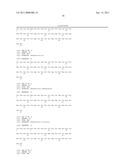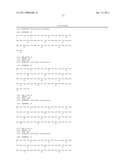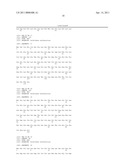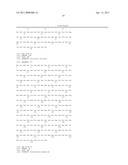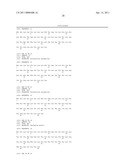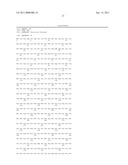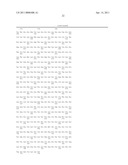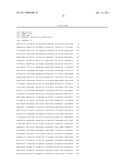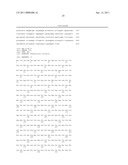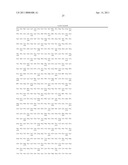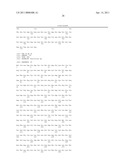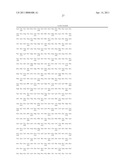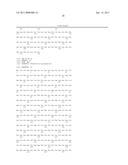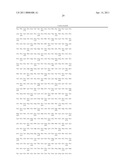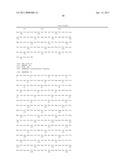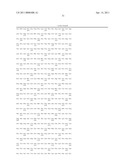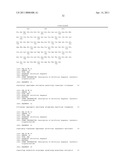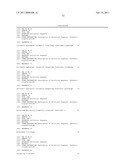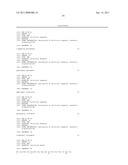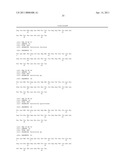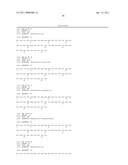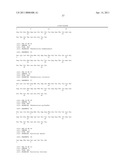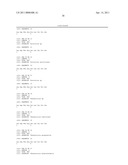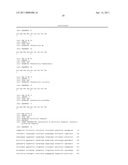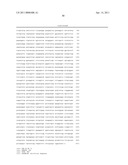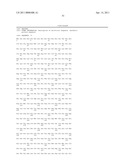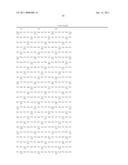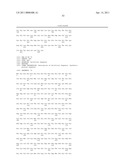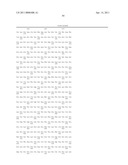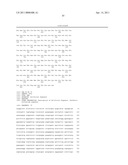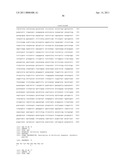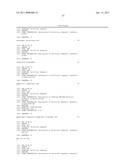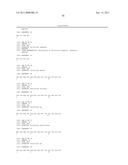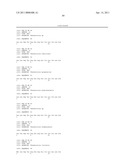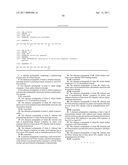Patent application title: Chimeric Polymerases
Inventors:
Patrick K. Martin (Redwood City, CA, US)
David A. Simpson (Redwood City, CA, US)
Assignees:
LIFE TECHNOLOGIES CORPORATION
IPC8 Class: AC12N912FI
USPC Class:
435194
Class name: Enzyme (e.g., ligases (6. ), etc.), proenzyme; compositions thereof; process for preparing, activating, inhibiting, separating, or purifying enzymes transferase other than ribonuclease (2.) transferring phosphorus containing group (e.g., kineases, etc.(2.7))
Publication date: 2011-04-14
Patent application number: 20110086406
Claims:
1. A chimeric polypeptide comprising a polymerizing domain and a dUTPase
domain.
2. The chimeric polypeptide of claim 1, wherein said polymerizing domain is positioned amino terminal to said dUTPase domain.
3. The chimeric polypeptide of claim 1, which further comprises a base analog detection domain.
4. The chimeric polypeptide of claim 3, which comprises a mutation that substantially inactivates said base analog detection domain.
5-12. (canceled)
13. The chimeric polypeptide of claim 1, which further comprises a 3'→5' exonuclease domain.
14. The chimeric polypeptide of claim 13, which comprises one or more mutations that substantially inactivate said exonuclease domain.
15-22. (canceled)
23. The chimeric polypeptide of claim 1, which is thermostable.
24. The chimeric polypeptide of claim 1, wherein said polymerizing domain is a type B polymerizing domain.
25. The chimeric polypeptide of claim 24, wherein said type B polymerizing domain comprises an amino acid sequence that has at least about 95% identity with an archaebacterium polymerase.
26. The chimeric polypeptide of claim 1, wherein said dUTPase domain comprises an amino acid sequence has at least about 95% identity with an archaebacterium dUTPase.
27-28. (canceled)
29. A chimeric polypeptide comprising a type B polymerizing domain and a dUTPase domain, wherein said polymerizing domain is positioned amino terminal to said dUTPase domain and said chimeric polypeptide is thermostable.
30. The chimeric polypeptide of 29, which further comprises a non-specific DNA binding domain.
31-40. (canceled)
41. The chimeric polypeptide of claim 29, which further comprises a 3'→5' exonuclease domain.
42. The chimeric polypeptide of claim 41, which comprises one or more mutations that substantially inactivate said exonuclease domain.
43-46. (canceled)
47. The chimeric polypeptide of claim 29, wherein said type B polymerizing domain comprises an amino acid sequence that has at least about 95% identity with an archaebacterium polymerase.
48. The chimeric polypeptide of claim 29, wherein said dUTPase domain comprises an amino acid sequence that has at least about 95% identity with an archaebacterium dUTPase.
49-50. (canceled)
51. A chimeric polypeptide comprising at least a type B polymerizing domain with reduced base analog detection activity and a non-specific nucleic acid binding domain that is at least about 95% identical to the amino acid sequence of Pae3192 or Ape3192.
52. The chimeric polypeptide of claim 51, which further comprises a dUTPase domain.
53. The chimeric polypeptide of claim 52, wherein said dUTPase domain is positioned carboxy terminal to said binding domain.
54. The chimeric polypeptide of claim 53, wherein said dUTPase domain has at least about 95% identity with an archaebacterium dUTPase.
55-87. (canceled)
Description:
1. CROSS REFERENCE TO RELATED APPLICATIONS
[0001] This application is a continuation of U.S. application Ser. No. 11/496,596, filed Jul. 31, 2006, which claims benefit under 35 U.S.C. §119(e) to application Ser. No. 60/704,013, filed Jul. 29, 2005, the contents of which are incorporated herein by reference.
2. BACKGROUND
[0002] DNA polymerases with 3'→5' exonuclease (proofreading) activity are the enzyme of choice for DNA amplification reactions where a high degree of fidelity is desired. The appeal of these polymerases is offset by their "read-ahead" activity which reduces processivity thereby reducing the yield of DNA amplification products. Read-ahead activity detects base-analogs that can be present in a DNA template and causes the polymerase to stall. Base-analogs arise in DNA as a result of various processes. For example, under thermocycling conditions, cytosine in DNA and dCTP monomers in solution deaminate and are thereby converted to uracil. Thus, uracil-containing DNA can arise from deamination of cytosine residues in a DNA template or by deamination of dCTP to dUTP and polymerase incorporation of the dUTP monomers into DNA. (Slupphaug et al. Anal Biochem. 1993; 211:164-169). Upon encountering uracil in a DNA template, the read-ahead activity causes the polymerase to stall upstream of the uracil residue. (Lasken et al. J Biol Chem. 1996; 271:17692-17696). Therefore, as the amount of uracil in DNA increases, the yield of amplification product decreases. Thus, there is a need in the art for DNA polymerases with reduced sensitivity to nucleotide analogs, such as uracil, that inhibit polymerase activity.
3. SUMMARY
[0003] These and other features of the present teachings are set forth herein.
[0004] The present disclosure provides chimeric polypeptides comprising heterologous amino acid sequences or domains. In some embodiments, a chimeric polypeptide can comprise a first domain having polymerizing activity joined to a second domain that reduces the sensitivity of the polymerizing domain to uracil. Therefore, disclosed herein are chimeric polymerases with reduced susceptibility to uracil poisoning. In various exemplary embodiments, the chimeric polymerases disclosed herein have reduced rates of dUTP incorporation into DNA and/or have reduced sensitivity to uracil in a DNA template. In various exemplary embodiments, a chimeric polymerase having one or more of these properties can comprise a polymerizing domain fused to an amino acid sequence having dUTPase activity and/or an amino acid sequence having double-stranded DNA binding activity.
[0005] In various exemplary embodiments, a domain having polymerizing activity can be a type A-, B-, C-, X-, or Y-family polymerase or a homolog or subsequence thereof suitable for catalyzing DNA polymerization in a template directed manner. In some embodiments, a domain having polymerizing activity can be a thermostable polymerase, such as, an Archaeal B-family DNA polymerase or an enzymatically active subsequence thereof. Non-limiting examples of Archaeal B-family DNA polymerases can include those from various Archaea genera, such as, Aeropyrum, Archaeglobus, Desulfurococcus, Pyrobaculum, Pyrococcus, Pyrolobus, Pyrodictium, Staphylothermus, Stetteria, Sulfolobus, Thermococcus, and Vulcanisaeta and the like. Examples of Archaeal B-family DNA polymerases include, but are not limited to, Vent®, Deep Vent®, Pfu, KOD, Pfx, Therminator, and Tgo polymerases.
[0006] In various exemplary embodiments, a domain having dUTPase activity can be a full-length dUTPase or a homolog or subsequence thereof sufficient to catalyze the hydrolysis of dUTP to dUMP and pyrophosphate. A dUTPase can be of prokaryotic, eukaryotic, (including nuclear and mitochondrial isoforms), or viral origin. In some embodiments, a dUTPase can be thermostable. Therefore, in some embodiments, a dUTPase can be from various Archaea genera, as described herein or known in the art.
[0007] In some embodiments, a domain having double-stranded DNA binding activity can be any amino acid sequence that binds double-stranded DNA in a sequence independent manner. In some embodiments, a double-stranded DNA binding domain increases the processivity of a chimeric polymerase in a template. In some embodiments, an amino acid sequence comprising sequence-independent, double-stranded DNA binding activity can be thermostable, such as, an Archaeal sequence-independent, double-stranded DNA binding protein (dsDBP). Non-limiting examples of Archaeal dsDBPs include, Ape3192, Pae3192, Sso7d, Smj12, Alba-1 (e.g., Sso10b-1, Sac10a), Alba-2, proliferating cell nuclear antigen (PCNA), including homologs and subsequences thereof.
[0008] In some embodiments, one or more mutations can be introduced into the sequence of a chimeric polypeptide to modify one or more activities of the various domains. Mutations can be any one or more of a substitution, insertion, and/or deletion of one or a plurality of amino acids. In various exemplary embodiments, a mutation can decrease the base analog detection or the 3'→5' exonuclease activity of chimeric polymerases. In some embodiments, a mutation can be suitable to increase the types of non-natural nucleotide base analogs that can be incorporated into a DNA strand by a chimeric polymerase. In some embodiments, a mutation can modify the specific activity of a polymerizing domain of a chimeric polypeptide.
[0009] The chimeric polypeptides disclosed herein can be synthesized by various methods. In some embodiments, a chimeric polypeptide can be expressed by a host cell from a recombinant polynucleotide vector comprising a sequence that encodes for the chimeric polypeptide. The recombinant vector can be made by ligating the appropriate polynucleotide sequences encoding the various domains and operatively linking the encoding sequence to a constitutive or inducible promoter, as known in the art. In various exemplary embodiments, a cell suitable for expressing a chimeric polypeptide can be a prokaryotic or eukaryotic cell. In some embodiments the domains comprising a chimeric polypeptide can be joined by chemical conjugation using one or more hetero-bifunctional coupling reagents, which can be cleavable or non-cleavable. Other non-limiting examples of coupling methods can utilize intermolecular disulfide bonds or thioether linkages. In some embodiments, the domains of a chimeric polypeptide can be joined by non-covalent interactions, such as, ionic interactions. (see, e.g. U.S. Pat. No. 6,627,424, WO/2001/92501).
[0010] The chimeric polypeptides disclosed herein find use in various methods, such as, synthesizing, analyzing, sequencing, modifying, and amplifying polynucleotide sequences. In some embodiments, a method of synthesizing a polynucleotide can comprise contacting a polynucleotide template with a primer and a chimeric polypeptide under conditions suitable for the chimeric polypeptide to extend the primer in a template directed manner. In some embodiments, a method of amplifying a target polynucleotide sequence comprises contacting a target sequence with a primer and a chimeric polypeptide under thermocycling conditions suitable for the chimeric polypeptide to amplify the target sequence. In some embodiments, a method of sequencing a polynucleotide can comprise contacting a target sequence with a primer and a chimeric polypeptide in the presence of nucleotide triphosphates and one or more chain terminating agents to generate chain terminated fragments; and determining the sequence of the polynucleotide by analyzing the fragments.
4. BRIEF DESCRIPTION OF THE DRAWINGS
[0011] The skilled artisan will understand that the drawings, described below, are for illustration purposes only and are not intended to limit the scope of the present disclosure in any way.
[0012] FIG. 1 shows an alignment of the amino acid sequences of a region of the read-ahead domain of Archaeal B-family polymerases. (Connolly et al. Biochem Soc Trans. 2003; 31:699; Fogg et al. Nature Struct Biol. 2002; 9:922-927; Shuttleworth et al. J Mol Biol. 2004; 337:621-634). The numbering of amino acids, such as, the amino acid residues at positions V93 and P115 including residues corresponding thereto is based on the number of amino acids of the full-length, mature polymerase B of Pyrococcus furiosus (P_fur, GenBank BAA02362, D12983 (SEQ ID NO:2). (Pyrococcus abyssi (P_abyssi (SEQ ID NO:1), GenBank P77916, AL096836); Pyrococcus species GB-D (P_GBD (SEQ ID NO:3), DEEP VENT®, GenBank PSU00707, AAA67131); Pyrococcus glycovorans (P_glycov (SEQ ID NO:4), GenBank AJ250335, CAC12849, TGL250335); Pyrococcus spp. ST700 (P_ST700 (SEQ ID NO:5), GenBank AJ250332, CAC12847); Thermococcus 9-degrees-Nm (T--9oNm (SEQ ID NO:6), Thermococcus sp. 9° N-7, GenBank U47108, AAA88769, TSU47108, **Q56366); Thermococcus fumicolans (T_fum (SEQ ID NO:7), GenBank TFDPOLEND, CAA93738); Thermococcus gorgonarius (T_gorg (SEQ ID NO:8), GenBank P56689); Thermococcus hydrothermalis (T_hydro (SEQ ID NO:9), GenBank THY245819, CAC18555); Thermococcus spp. JDF-3 (T_JDF3 (SEQ ID NO:10), GenBank AX135456; WO0132887); Thermococcus kodakarensis (T_KOD (SEQ ID NO:11), GenBank BAA06142, BD175553); Thermococcus litoralis (T_lit (SEQ ID NO:12), VENT®, GenBank AAA72101); Thermococcus profundus (T_profundus (SEQ ID NO:13), GenBank E14137; CAPLUS/REGISTRY Database 199455-28-2 (T. profundus strain DT5432 (9CI)); JP1997275985A)).
[0013] FIG. 2 Panel A provides a cartoon of a non-limiting example of an Archaeal type-B DNA polymerase comprising a polymerizing domain and a 3'→5' exonuclease domain (3'→5' exo). Panels B-E provide cartoons of non-limiting examples of chimeric polymerases comprising Archael type-B DNA polymerizing domain jointed to a dUTPase and/or a non-specific dsDNA binding domain ("BP") and/or a 3'→5' exo domains.
[0014] FIG. 3 shows the amino acid sequences of non-specific DNA binding protein Sso7d which is present in the Sulfolobus sulfataricus P2 genome (see GenBank NC 002754) in three nearly-identical open reading frames: Sso10610 (SEQ ID NO:14), Sso9180 (SEQ ID NO:15), Sso9535 (SEQ ID NO:16). (Gao et al. Nature Struct Biol. 1998; 5:782-786).
[0015] FIG. 4 shows the amino acid sequence of non-specific DNA binding protein Smj12 of the Sulfolobus sulfataricus P2 genome (see GenBank NC 002754) open reading frame Sso0458 (SEQ ID NO:17). (Napoli et al. J Biol Chem. 2001; 276:10745-10752).
[0016] FIG. 5 shows the amino acid sequence of non-specific DNA binding protein Alba-1 (Sso10b-1, Sac10a) of the Sulfolobus sulfataricus P2 genome (see GenBank NC--002754) open reading frame Sso0962 (SEQ ID NO:18). (Wardleworth et al. EMBO J. 2002; 21:4654-4652).
[0017] FIG. 6 shows the amino acid sequence of non-specific DNA binding protein Alba-2 of the Sulfolobus sulfataricus P2 genome (see GenBank NC 002754) open reading frame Sso6877 (SEQ ID NO:19). (Chou et al. J Bacteriol. 2003; 185:4066-4073).
[0018] FIG. 7 shows the amino acid sequence of proliferating cell nuclear antigen homolog of P. furiosus (Pfu PCNA (SEQ ID NO:20)) (GenBank AB017486, BAA33020). (Cann et al. J Bacteriol. 1999; 181-6591-6599; Motz et al. J Biol Chem. 2002; 277:16179-16188).
[0019] FIG. 8 shows the amino acid sequence of non-specific DNA binding proteins Pae3192 (SEQ ID NO:21), Pae3289 (SEQ ID NO:22), and Pae0384 (SEQ ID NO:23) of Pyrobaculum aerophilum strain IM2 (GenBank NC--003364).
[0020] FIG. 9 shows the amino acid sequence of non-specific DNA binding protein Ape3192 (SEQ ID NO:24) of Aeropyrum pemix (GenBank NC--000854).
[0021] FIG. 10 shows the amino acid sequence of Pyrococcus furiosus DNA polymerase (SEQ ID NO:25) (Pfu, GenBank D12983, BAA02362)
[0022] FIG. 11 shows the nucleic acid sequence encoding the amino acid sequence of Thermococcus kodakarensis strain KOD1 DNA polymerase (SEQ ID NO:26) (GenBank BD175553).
[0023] FIG. 12 shows the amino acid sequence of VENT® DNA polymerase (SEQ ID NO:27) (GenBank AAA72101).
[0024] FIG. 13 shows the amino acid sequence of DEEP VENT® DNA polymerase (SEQ ID NO:28) (GenBank AAA67131).
[0025] FIG. 14 shows amino acid sequence of Tgo DNA polymerase (SEQ ID NO:29) (GenBank P56689, Hopfner et al. Proc Natl Acad Sci USA. 1999 Mar. 30; 96(7):3600-5).
[0026] FIG. 15 shows the amino acid sequence of Archaeoglobus fulgidus DNA polymerase (SEQ ID NO:30) (GenBank O29753).
[0027] FIG. 16 shows an alignment of the amino acid sequence of Archaeal DNA polymerases. The numbering of amino acids, such as, the amino acid residues at positions 247, 265, 408, and 485 is based on the number of amino acids of the full-length polymerase B of Pyrococcus furiosus (GenBank BAA02362); Pyrococcus abyssi (GenBank P77916); Pyrococcus furiosus (GenBank BAA02362); Pyrococcus species GB-D (GenBank PSU00707)); Pyrococcus glycovorans (GenBank CAC12849); Pyrococcus sp. ST700 (GenBank CAC12847); Thermococcus 9-degrees-Nm (Thermococcus sp. 9oN-7 (GenBank AAA887669); Thermococcus fumicolans (GenBank CAA93738); Thermococcus gorgonarius (GenBank P56689, 1QQCA, 1D5AA); Thermococcus hydrothermalis (GenBank CAC18555); Thermococcus sp. JDF-3 (GenBank AX135456; WO0132887); Thermococcus kodakarensis (GenBank BAA06142); Thermococcus litoralis (GenBank AAA72101); Thermococcus profundus (GenBank E14137; JP1997275985A). Panel A shows Forked Point substitutions (P_abyssi (SEQ ID NO:46), P_fur (SEQ ID NO:47), P_GBD (SEQ ID NO:48), P_glycov (SEQ ID NO:49), P_ST700 (SEQ ID NO:50), T--9oNm (SEQ ID NO:51), T_fum (SEQ ID NO:52), T_gorg (SEQ ID NO:53), T_hydro (SEQ ID NO:54), T_JDF3 (SEQ ID NO:55), T_KOD (SEQ ID NO:56), T_lit (SEQ ID NO:57), T_profundus (SEQ ID NO:58)). Panel B shows Finger substitutions (P_abyssi (SEQ ID NO:59), P_fur (SEQ ID NO:60), P_GBD (SEQ ID NO:61), P_glycov (SEQ ID NO:62), P_ST700 (SEQ ID NO:63), T--9oNm (SEQ ID NO:64), T_fum (SEQ ID NO:65), T_gorg (SEQ ID NO:66), T_hydro (SEQ ID NO:67), T_JDF3 (SEQ ID NO:68), T_KOD (SEQ ID NO:69), T_lit (SEQ ID NO:70), T_profundus (SEQ ID NO:71)). See FIG. 2 for key.
[0028] FIG. 17 shows the results of a PCR reaction performed in the presence of varying dTTP/dUTP ratios using a non-limiting example of a chimeric polymerase comprising: (i) Pfu polymerizing domain fused at its carboxy terminus to non-specific DNA binding protein Pae3192; and (ii) a chimeric polymerase comprising Pfu polymerizing domain fused at its carboxy terminus with non-specific DNA binding protein Pae3192 and further comprising substitution of a glutamine (Q) for valine-93 (V93Q, see FIG. 1), which substantially inactivates the base analog detection domain.
[0029] FIG. 18 shows oligonucleotides utilized in the assembly of a polynucleotide that encodes a thermostable dUTPase. (dut1 (SEQ ID NO:31), dut2 (SEQ ID NO:32), dut3 (SEQ ID NO:33), dut4 (SEQ ID NO:34), dut5 (SEQ ID NO:35), dut6 (SEQ ID NO:36), dut7 (SEQ ID NO:37), dut8 (SEQ ID NO:38), duta (SEQ ID NO:39), dutb (SEQ ID NO:40), dutc (SEQ ID NO:41), dutd (SEQ ID NO:42), dute (SEQ ID NO:43), dutf (SEQ ID NO:44), dutg (SEQ ID NO:45)).
[0030] FIG. 19 shows the DNA sequence encoding chimeric polymerase comprising an amino terminal histidine tail: His10-Pfu-Ape3192(V93Q) (SEQ ID NO:72).
[0031] FIG. 20 shows the amino acid sequence of chimeric polymerase comprising an amino terminal histidine tail: His10-Pfu-Ape3192(V93Q) (SEQ ID NO:73).
[0032] FIG. 21 shows the amino acid sequence of chimeric polymerase comprising an amino terminal histidine tail: His10-Pfu-Pae3192(V93Q) (SEQ ID NO:74).
[0033] FIG. 22 shows the DNA sequence encoding chimeric polymerase comprising an amino terminal histidine tail: His10-Pfu-Pae3192(V93Q) (SEQ ID NO:75).
5. DETAILED DESCRIPTION
[0034] It is to be understood that both the foregoing general description, including the drawings, and the following detailed description are exemplary and explanatory only and are not restrictive of this disclosure. In this disclosure, the use of the singular includes the plural unless specifically stated otherwise. Also, the use of "or" means "and/or" unless stated otherwise. Similarly, "comprise," "comprises," "comprising" "include," "includes," and "including" are not intended to be limiting. Terms such as "element" or "component" encompass both elements and components comprising one unit and elements or components that comprise more than one unit unless specifically stated others. The sectional heads used herein are for organizational purposes only and are not to be construed as limiting the subject matter described. All references and portions of references cited, including but not limited to patents, patent applications, articles, books, and treatises are hereby expressly incorporated by reference in their entirely for any purpose. In the event that one or more of the incorporated references contradicts this disclosure, this disclosure controls.
5.2 Definitions
[0035] "Protein," "polypeptide," "oligopeptide," and "peptide" are used interchangeably to denote a polymer of at least two amino acids covalently linked by an amide bond, regardless of length or post-translational modification (e.g., glycosylation, phosphorylation, lipidation, myristilation, ubiquitination, etc.). Included within this definition are D- and L-amino acids, and mixtures of D- and L-amino acids.
[0036] "Nucleobase polymer" and "oligomer" refer to two or more nucleobases connected by linkages that permit the resultant nucleobase polymer or oligomer to hybridize to a polynucleotide having a complementary nucleobase sequence. Nucleobase polymers or oligomers include, but are not limited to, poly- and oligonucleotides (e.g., DNA and RNA polymers and oligomers), poly- and oligonucleotide analogs and poly- and oligonucleotide mimics, such as polyamide or peptide nucleic acids. Nucleobase polymer and oligomer include, but are not limited to, mixed poly- and oligonucleotides (e.g., a combination of DNA, RNA, and/or peptide nucleic acids and the like). Nucleobase polymers or oligomers can vary in size from a few nucleobases, from about 2 to about 40 nucleobases, to about several hundred nucleobases, to about several thousand nucleobases, or more.
[0037] "Polynucleotide" and "oligonucleotide" refer to nucleobase polymers or oligomers in which the nucleobases are connected by sugar phosphate linkages (e.g., a sugar-phosphate backbone). Exemplary poly- and oligonucleotides include polymers of 2'-deoxyribonucleotides (e.g., DNA) and polymers of ribonucleotides (e.g., RNA). In various exemplary embodiments, a polynucleotide may be composed entirely of ribonucleotides, entirely of 2'-deoxyribonucleotides, or combinations thereof.
[0038] "Polynucleotide analog" and "oligonucleotide analog" refer to nucleobase polymers or oligomers in which the nucleobases are connected by a sugar phosphate backbone comprising one or more sugar phosphate analogs. Typical sugar phosphate analogs include, but are not limited to, sugar alkylphosphonates, sugar phosphoramidites, sugar alkyl- or substituted alkylphosphotriesters, sugar phosphorothioates, sugar phosphorodithioates, sugar phosphates and sugar phosphate analogs in which the sugar is other than 2'-deoxyribose or ribose, nucleobase polymers having positively charged sugar-guanidyl interlinkages such as those described in U.S. Pat. Nos. 6,013,785, 5,696,253 (see also, Dagani, 1995, Chem. & Eng. News 4-5:1153; Dempey et al., 1995, J. Am. Chem. Soc. 117:6140-6141). Such positively charged analogues in which the sugar is 2' deoxyribose are referred to as "DNGs," whereas those in which the sugar is ribose are referred to as "RNGs." Specifically included within the definition of poly- and oligonucleotide analogs are locked nucleic acids (LNAs; see, e.g., Elayadi et al. 2002, Biochemistry 41:9973-9981; Koshkin et al., 1998, J. Am. Chem. Soc. 120:13252-3; Koshkin et al., 1998, Tetrahedron Letters, 39:4381-4384; Jumar et al., 1998, Bioorganic & Medicinal Chemistry Letters 8:2219-2222; Singh and Wengel, 1998, Chem. Commun., 12:1247-1248; WO 00/56746; WO 02/28875; and WO 01/48190.
[0039] "Polynucleotide mimic" and "oligonucleotide mimic" refers to a nucleobase polymer or oligomer in which one or more of the backbone sugar-phosphate linkages is replaced with a sugar-phosphate analog. Such mimics are capable of hybridizing to complementary polynucleotides or oligonucleotides, or polynucleotide or oligonucleotide analogs or to other polynucleotide or oligonucleotide mimics, and may include backbones comprising one or more of the following linkages: positively charged polyamide backbone with alkylamine side chains as described in U.S. Pat. Nos. 5,786,461, 5,766,855, 5,719,262, 5,539,082 and WO 98/03542 (see also, Haaima et al., 1996, Angewandte Chemie Int'l Ed. in English 35:1939-1942; Lesnick et al., 1997, Nucleotid. 16:1775-1779; D'Costa et al., 1999, Org. Lett. 1:1513-1516; Nielsen, 1999, Curr. Opin. Biotechnol. 10:71-75); uncharged polyamide backbones as described in WO92/20702 and U.S. Pat. No. 5,539,082; uncharged morpholino-phosphoramidate backbones as described in U.S. Pat. Nos. 5,698,685, 5,470,974, 5,378,841, and 5,185,144 (see also, Wages et al., 1997, BioTechniques 23:1116-1121); peptide-based nucleic acid mimic backbones (see, e.g., U.S. Pat. No. 5,698,685); carbamate backbones (see, e.g., Stirchak and Summerton, 1987, J. Org. Chem. 52:4202); amide backbones (see, e.g., Lebreton, 1994, Synlett. February, 1994: 137); methylhydroxyl amine backbones (see, e.g., Vasseur et al., 1992, J. Am. Chem. Soc. 114:4006); 3'-thioformacetal backbones (see, e.g., Jones et al., 1993, J. Org. Chem. 58:2983) and sulfamate backbones (see, e.g., U.S. Pat. No. 5,470,967). All of the preceding references are herein incorporated by reference.
[0040] "Fused," "joined" and grammatical equivalents are used herein refers to linkage of heterologous amino acid or polynucleotide sequences. Thus, "fused" refers to any method known in the art for functionally connecting polypeptide and/or polynucleotide sequences, such as, domains, including but not limited to recombinant fusion with or without intervening linking sequence(s), domain(s) and the like, non-covalent association, and covalent bonding.
[0041] "Chimeric polypeptide" and grammatical equivalents refers to a polypeptide comprising two or more heterologous domains, amino acid sequences, peptides, and/or proteins joined either covalently or non-covalently to produce a polypeptide that does not occur in nature. Therfore, a chimera includes a fusion of a first amino acid sequence joined to a second amino acid sequence, wherein the first and second amino acid sequences are not found in the same relationship in nature. As used herein, "joined" and "fused" refer to any method known in the art for functionally connecting polypeptide domains, including without limitation recombinant fusion with or without intervening domain(s), sequence(s) and the like, intein-mediated fusion, non-covalent association, and covalent bonding, including disulfide bonding, hydrogen bonding, electrostatic bonding, and conformational bonding.
[0042] "Heterologous" as used herein with reference to chimeric polypeptides refers to two or more domains or sequences that are not found in the same relationship to each other in nature. Therefore, a fusion of two or more heterologous domains or sequences from unrelated proteins can yield a chimeric polypeptide.
[0043] "Domain" as used herein refers to an amino acid sequence of a chimeric polypeptide comprising one or more defined functions or properties.
[0044] "Nucleic acid polymerase" or "polymerase" refers to a polypeptide that catalyzes the synthesis of a polynucleotide using an existing polynucleotide as a template. Therefore, in various exemplary embodiments, a polymerase can be a DNA-dependent DNA polymerase, an RNA-dependent DNA polymerase, an RNA-dependent RNA polymerase, etc.
[0045] "DNA polymerase" as used herein refers to a nucleic acid polymerase capable of catalyzing the synthesis of DNA using a polynucleotide template.
[0046] "Thermostable" as used herein refers to a polypeptide which does not become irreversibly denatured (inactivated) when subjected to elevated temperatures for the time necessary to effect denaturation of double-stranded nucleic acids. The heating conditions necessary for nucleic acid denaturation are well known in the art and are exemplified in U.S. Pat. Nos. 4,683,202 and 4,683,195. Irreversible denaturation for purposes herein refers to permanent and at least substantial loss of activity, structure, or function. In various exemplary embodiments, a thermostable polypeptide is not irreversibly denatured following incubation of at least about 50° C., 60° C., 70° C., 80° C., or 90° C., or higher for 3, 4, 5, 6, 7, 8, 9, 10, or more minutes.
[0047] "Polymerase activity" refers to the activity of a nucleic acid polymerase in catalyzing the template-directed synthesis of a polynucleotide. Polymerase activity can be measured using various techniques and methods known in the art. For example, serial dilutions of polymerase can be prepared in dilution buffer (20 mM Tris.Cl, pH 8.0, 50 mM KCl, 0.5% NP 40, and 0.5% Tween-20). For each dilution, 5 μl can be removed and added to 45 μl of a reaction mixture containing 25 mM TAPS (pH 9.25), 50 mM KCl, 2 mM MgCl2, 0.2 mM dATP, 0.2 mM dGTP, 0.2 mM dTTP, 0.1 mM dCTP, 12.5 μg activated DNA, 100 μM [α-32P]dCTP (0.05 μCi/nmol) and sterile deionized water. The reaction mixtures can be incubated at 37° C. (or 74° C. for thermostable DNA polymerases) for 10 minutes and then stopped by immediately cooling the reaction to 4° C. and adding 10 μl of ice-cold 60 mM EDTA. A 25 μl aliquot can be removed from each reaction mixture. Unincorporated radioactively labeled dCTP can be removed from each aliquot by gel filtration (Centri-Sep, Princeton Separations, Adelphia, N.J.). The column eluate can be mixed with scintillation fluid (1 ml). Radioactivity in the column eluate is quantified with a scintillation counter to determine the amount of product synthesized by the polymerase. One unit of polymerase activity can be defined as the amount of polymerase necessary to synthesize 10 nmole of product in 30 minutes. (Lawyer et al. (1989) J. Biol. Chem. 264:6427-647). Other methods of measuring polymerase activity are known in the art (see, e.g. Sambrook et al. (2001) Molecular Cloning: A Laboratory Manual (3rd ed., Cold Spring Harbor Laboratory Press, NY)).
[0048] "Processivity" refers to the ability of a polymerase to perform a sequence of polymerization steps without intervening dissociation of the polymerase from the growing polynucleotide strand. Thus, processivity can be measured by the number of nucleotides a polymerase can add to a primer terminus during a polymerization cycle. "Polymerization cycle" includes the steps of "diffusion of the enzyme to the primer terminus . . . the ordered binding of a nucleotide, base pairing with template, covalent linkage to the primer terminus, and then translocation of the enzyme to the newly created primer terminus The enzyme either dissociates at this point to complete the cycle or continues processively." (Kornberg, DNA Replication, p. 122 (Freeman & Co. 1980 (ISBN: 0716711028)). Therefore, processivity refers to the number of nucleotides added by a polymerase to an oligonucleotide primer while the polymerase is in contact with the primer and template during a polymerization cycle.
[0049] "Nucleic acid binding activity" refers to the activity of a polypeptide in binding nucleic acid in a two band-shift assay. For example, in some embodiments (based on the assay of Guagliardi et al. (1997) J. Mol. Biol. 267:841-848), double-stranded nucleic acid (the 452-bp HindIII-EcoRV fragment from the S. solfataricus lacS gene) is labeled with 32P to a specific activity of at least about 2.5×107 cpm/ug (or at least about 4000 cpm/fmol) using standard methods. See, e.g., Sambrook et al. (2001) Molecular Cloning: A Laboratory Manual (3rd ed., Cold Spring Harbor Laboratory Press, NY) at 9.63-9.75 (describing end-labeling of nucleic acids). A reaction mixture is prepared containing at least about 0.5 μg of the polypeptide in about 10 μl of binding buffer (50 mM sodium phosphate buffer (pH 8.0), 10% glycerol, 25 mM KCl, 25 mM MgCl2). The reaction mixture is heated to 37° C. for 10 min. About 1×104 to 5×104 cpm (or about 0.5-2 ng) of the labeled double-stranded nucleic acid is added to the reaction mixture and incubated for an additional 10 min. The reaction mixture is loaded onto a native polyacrylamide gel in 0.5× Tris-borate buffer. The reaction mixture is subjected to electrophoresis at room temperature. The gel is dried and subjected to autoradiography using standard methods. Any detectable decrease in the mobility of the labeled double-stranded nucleic acid indicates formation of a binding complex between the polypeptide and the double-stranded nucleic acid. Such nucleic acid binding activity may be quantified using standard densitometric methods to measure the amount of radioactivity in the binding complex relative to the total amount of radioactivity in the initial reaction mixture.
[0050] In some embodiments, (based on the assay of Mai et al. (1998) J. Bacteriol. 180:2560-2563), about 0.5 μg each of negatively supercoiled circular pBluescript KS(-) plasmid and nicked circular pBluescript KS(-) plasmid (Stratagene, La Jolla, Calif.) are mixed with a polypeptide at a polypeptide/DNA mass ratio of about ≧2.6. The mixture is incubated for 10 min at 40° C. The mixture is subjected to 0.8% agarose gel electrophoresis. DNA is visualized using an appropriate dye. Any detectable decrease in the mobility of the negatively supercoiled circular plasmid and/or nicked circular plasmid indicates formation of a binding complex between the polypeptide and the plasmid.
[0051] "Corresponding" as used herein refers to being similar or equivalent in character, structure, or function. Therefore, "corresponding amino acid" refers to an amino acid at a position in a polypeptide that is similar or equivalent in character, structure, or function to an amino acid in another polypeptide. In some embodiments, corresponding amino acids in two or more polypeptides can be identified by aligning polypeptide sequences using various algorithms as known in the art. (see, e.g. FIG. 1, FIGS. 16A and 16B). In some embodiments, corresponding amino acids can be identified by aligning the polynucleotide sequences encoding the polypeptides. Algorithms suitable for aligning polypeptide or polynucleotide sequences in include the algorithms of Smith & Waterman, Adv. Appl. Math. 1981; 2:482, Needleman & Wunsch, J. Mol. Biol. 1970; 48:443, Pearson & Lipman, Proc Natl Acad Sci USA. 1998; 85:2444 and computerized implementations of these algorithms (e.g., GAP, BESTFIT, FASTA, and TFASTA). In some embodiments, sequence can be aligned by manually by visual inspection (see, e.g., Current Protocols in Molecular Biology (Ausubel et al., eds. 1995 supplement)). Other algorithms include PILEUP (Feng & Doolittle. J. Mol. Evol. 1987: 35:351-360; Devereaux et al., Nuc. Acids Res. 1984; 12:387-395), BLAST and BLAST 2.0 algorithms, which are described in Altschul et al. Nuc. Acids Res. 1977; 25:3389-3402; Altschul et al. J Mol Biol. 1990; 215:403-410; and; Karlin & Altschul. Proc. Natl. Acad. Sci. USA 1993; 90:5873-5787. Software for performing BLAST analyses is publicly available through the National Center for Biotechnology Information. In various exemplary embodiments, the default parameters of each of the alignment algorithms can be used.
[0052] Similarly, "corresponding nucleotides" can be identified by aligning two or more polynucleotide sequences using, for example, the Basic Local Alignment Search Tool (BLAST) engine. (Tatusova et al. (1999) FEMS Microbiol Lett. 174:247-250). The BLAST engine (version 2.2.10) is available to the public at the National Center for Biotechnology Information (NCBI), Bethesda, Md. To align two polynucleotide sequences, the "Blast 2 Sequences" tool can be used, which employs the "blastn" program with parameters set at default values (Matrix: not applicable; Reward for match: 1; Penalty for mismatch: -2; Open gap: 5 penalties; Extension gap: 2 penalties; Gap_x dropoff: 50; Expect: 10.0; Word size: 11; Filter: On).
[0053] "Native sequence" as used herein refers to a polynucleotide or amino acid isolated from a naturally occurring source. Included within "native sequence" are recombinant forms of a native polypeptide or polynucleotide which have a sequence identical to the native form.
[0054] "Mutant" or "variant" as used herein refers to an amino acid or polynucleotide sequence which has been altered by substitution, insertion, deletion and/or chemical modification. In some embodiments, a mutant or variant sequence can have increased, decreased, or substantially similar activities or properties in comparison to the parental sequence. In various exemplary embodiments, a "parental sequence" can be a wild-type sequence or another mutant or variant sequence. Exemplary activities or properties include but are not limited to polymerization, 3'→5' exonuclease activity, base analog detection activities, such as uracil detection in DNA and inosine detection. A "mutant"or "variant" polymerase can be a chimeric polypeptide, such as a chimeric polymerase, as described herein.
[0055] "Host cell" as used herein refers to both single-cell prokaryote and eukaryote organisms such as bacteria, yeast, archaea, actinomycetes and single cells from higher order plants or animals grown in cell culture.
[0056] "Expression vector" as used herein refers to polynucleotide sequences containing a desired polypeptide coding sequence and control sequences in operable linkage, so that host cells transformed with polynucleotide sequences are capable of producing the encoded proteins either constitutively or via induction.
[0057] "Primer" as used herein refers to an oligonucleotide, whether natural or synthetic, which is capable of hybridizing to a template in a manner suitable to form a substrate for a polymerase. The appropriate length of a primer can vary by generally from about 15 to about 35 nucleotides. A primer need not reflect the exact sequence of the template but must be sufficiently complementary to hybridize with a template under polymerization conditions. In some embodiments, a primer can comprise a label suitable for detection by spectroscopic, photochemical, biochemical, immunochemical, or chemical methods.
[0058] "Archaeal" DNA polymerase refers to DNA polymerases that belong to either the Family B/pol I-type group (e.g., Pfu, KOD, Pfx, Vent, Deep Vent, Tgo, Pwo) or the pol II group (e.g., Pyrococcus furiosus DP1/DP2 2-subunit DNA polymerase). In some embodiments, "Archaeal" DNA polymerases can be thermostable Archaeal DNA polymerases and include, but are not limited to, DNA polymerases isolated from Pyrococcus species (e.g., furiosus, species GB-D, woesii, abysii, horikoshii), Thermococcus species (kodakaraensis KODI, litoralis, species 9 degrees North-7, species JDF-3, gorgonarius), Pyrodictium occultum, and Archaeoglobus fulgidus. Archaeal pol I DNA polymerase group can be commercially available, including Pfu (Stratagene), KOD (Toyobo), Pfx (Life Technologies, Inc.), Vent (New England BioLabs), Deep Vent (New England BioLabs), Tgo (Roche), and Pwo (Roche). Additional archaea related to those listed above are described in the following references: Archaea: A Laboratory Manual (Robb, F. T. and Place, A. R., eds.), Cold Spring Harbor Laboratory Press, Cold Spring Harbor, N.Y., 1995.
5.3 Exemplary Embodiments
[0059] The present disclosure provides chimeric polypeptides comprising fusions of a DNA polymerizing domain and a heterologous domain to produce chimeric polymerases with reduced sensitivity to uracil. In some embodiments, a polymerizing domain can be fused to a dUTPase domain which converts dUTP to dUMP and pyrophosphate. dUMP and pyrophosphate are not suitable substrates for DNA polymerization and, therefore, are not utilized by the polymerizing domain. Accordingly, in some embodiments a chimeric polymerase can reduce the concentration of dUTP in a polymerization reaction before it can be incorporated into a newly synthesized DNA strand. As a result, the frequency or probability of polymerase stalling upon contacting a uracil-containing DNA can be substantially reduced. In some embodiments, chimeric polymerases with reduced sensitivity to uracil-containing DNA can comprise a fusion of a polymerizing domain and a heterologous domain that increases polymerase processivity (i.e., a processivity domain). Therefore, in some embodiments, a chimeric polymerase can substantially elide uracil-containing DNA. In some embodiments, a chimeric polymerase can comprise polymerizing, dUTPase, and processivity domains. In some embodiments, a chimeric polymerase can comprising one or more mutations to further decrease sensitivity to uracil and/or other types of base analogs that can be present in DNA templates. (FIG. 2A-E, 19-22).
[0060] Thus, "chimeric polymerase" as used herein refers to a polypeptide that does not occur in nature that comprises a fusion of two or more heterologous amino acid sequences or domains. Therefore, excluded from the definition of chimeric polymerases are naturally-occurring polypeptide fusions. These naturally-occurring fusions can be produced by various mechanisms, as known by the skilled artisan. For example, naturally-occurring fusions can be encoded by the genomes of various organisms, such as, viruses. Generally, naturally-occurring fusions can be post-translationally processed, for example, by viral and/or cellular proteases to yield discrete proteins. Non-limiting examples of naturally-occurring fusions are produced by retroviruses (e.g., pol, gag-pol, gag-pro, gag-pro-pol), togaviruses (e.g., nsP1-nsP2-nsp3-nsP4), picornaviruses (e.g., P1-P2-P3), and flaviviruses (e.g., C-prM-E-NS1-NS2A-NS3-NS4A-NS4B-NS5) etc. (Bannert. Proc Natl Acad Sci USA. 2004; 101:14572; Fields Virology 685-840, 895-1162, 1871-2140 (Knipe & Howley, editors-in-chief, 4th ed., Lippincott Williams & Wilkins 2001 (ISBN: 0781718325); McGeoch. Nucl Acids Res. 1990; 18:4105-4110).
[0061] In contrast, the chimeric polymerases disclosed herein are hybrids that are engineered to contain elements or properties of two or more heterologous, donor polypeptides. The donor polypeptides can be from the same or different organisms (e.g., strains, subspecies, species, genera, families, kingdoms, etc.), can have distinct or related properties, can comprise native or mutant sequences, and can comprise the full-length polypeptide or one or more subsequences or fragments or domains thereof. The number and type of amino acid sequences from donor polypeptides that can be fused can be selected at the discretion of the practitioner.
[0062] "Polymerizing domain" as used herein refers to an amino acid sequence capable of catalyzing the synthesis of a polynucleotide using an existing polynucleotide strand as a template. Therefore, in various exemplary embodiments, a polymerizing domain can be a full-length polymerase or any fragment thereof capable of catalyzing polynucleotide synthesis in a template directed manner with or without the use of auxiliary proteins as known in the art (see, e.g. Kornberg, DNA Replication (ISBN: 0716720035); Friedberg et al. DNA Repair And Mutagenesis (ISBN: 1555813194); Alberts et al. Molecular Biology of the Cell, Fourth Edition (ISBN: 0815332181)). As the skilled artisan will appreciate, substrates suitable for polymerization include an oligonucleotide primer annealed to a template in a manner suitable for the template to form a 5' overhang relative to the 3' terminus of the primer (i.e., a primed template strand). Under suitable conditions as known in the art, a polymerizing domain utilizes nucleotide triphosphates to extend the 3' terminus of the annealed primer. The sequence of the template directs the incorporation of nucleotides into the nascent strand to yield a polynucleotide that is the reverse complement of the template. Reaction conditions suitable for polymerization are well-known in the art and vary depending on the properties of the polymerizing domain, as described below. Other parameters include but are not limited to the composition of the nucleotide triphosphates (e.g., dNTPs, rNTPs), the template and primer (e.g., DNA, RNA), cofactors (e.g., divalent metal ions), ionic strength, pH, and temperature (Innis et al. PCR Protocols: A Guide to Methods and Applications 1-482 (Academic Press (ISBN: 0123721814); Sambrook & Russell, Molecular Cloning: A Laboratory Manual 7.75-8.126, A4.11-A4.29 (3d Cold Spring Harbor Laboratory Press (ISBN: 0879695773)).
[0063] Polymerizing domains suitable for use as a chimeric polypeptide can be any of the various polymerases of eukaryotic and prokaryotic cells (e.g., archaebacteria, eubacteria), mitochondria, and viruses. In some embodiments, a polymerizing domain can be a DNA polymerizing domain of an A, B, C, D, X, Y or other polymerase family. The A, B, and C polymerase families are classified based on their amino acid sequence homology with the product of the polA, polB, or polC gene of E. coli that encode, respectively, for DNA polymerase I, II, and III (alpha subunit). The properties and enzymatic activities of each family of polymerase is known in the art. (Braithwaite et al. Nucleic Acids Res. 1993 Feb. 25; 21(4):787-802; Ito et al. Nucleic Acids Res. 1991 Aug. 11; 19(15):4045-57; Sambrook & Russell, Molecular Cloning: A Laboratory Manual 7.75-8.126, A4.11-A4.29 (3d Cold Spring Harbor Laboratory Press (ISBN: 0879695773)).
[0064] In addition to E. coli DNA polymerase I, other non-limiting examples of A family polymerases include Bacillus, Rhodothermus, Thermotoga (e.g., Thermotoga maritima (ULTma®, New England Biolabs, Beverly, Mass.), Streptococcus pneumonia, Thermus aquaticus (e.g., Taq, Amplitaq®) and Thermus flavus (e.g., HOT TUB®, Pyrostase®) Thermus thermophilus (e.g., Tth) DNA polymerases; T5, T7, SPO1, and SPO2 bacteriophage DNA polymerases; and yeast mitochondrial DNA polymerase (MIPI). (Akhmetzjanov et al. Nucleic Acids Res. 1992 Nov. 11; 20(21):5839; Al-Soud et al., Appl Env Micro. 1998; 64:3748; Blanco et al. Nucleic Acids Res. 1991 Feb. 25; 19(4):955; Dunn et al. J Mol Biol. 1983 Jun. 5; 166(4):477-535; Foury et al. J Biol Chem. 1989 Dec. 5; 264(34):20552-60; Hahn et al. Nucleic Acids Res. 1989 Aug. 25; 17(16):6729; Hollingsworth et al. J Biol Chem. 1991 Jan. 25; 266(3):1888-97; Ito et al. Nucleic Acids Res. 1990 Nov. 25; 18(22):6716; Johnson et al. J Biol Chem. 2003; 278:23762; Joyce et al. J Biol Chem. 1982 Feb. 25; 257(4):1958-64; Kaliman et al. FEBS Lett. 1986 Jan. 20; 195(1-2):61-4; Lawyer et al. J Biol Chem. 1989 Apr. 15; 264(11):6427-37; Leavitt et al. Proc Natl Acad Sci USA. 1989 June; 86(12):4465-9; Raden et al. J Virol. 1984 October; 52(1):9-15; Scarlato et al. Gene. 1992 Sep. 1; 118(1):109-13; Yehle et al. J Biol Chem. 1973; 248:7456-7463).
[0065] Examples of B family DNA polymerases include E. coli DNA polymerase II; PRD1, φ29, M2, and T4 bacteriophage DNA polymerases; archaebacterial DNA polymerase I (e.g. Thermococcus litoralis (Vent®, GenBank: AAA72101, FIG. 12), Pyrococcus furiosus (Pfu, GenBank: D12983, BAA02362, FIG. 10), Pyrococcus GB-D (Deep Vent®, GenBank: AAA67131, FIG. 13), Thermococcus kodakaraensis KODI (KOD, GenBank: BD175553, FIG. 11; Thermococcus sp. strain KOD (Pfx, GenBank: AAE68738)), Thermococcus gorgonarius (Tgo, GenBank: P56678, O29753, FIG. 14), Sulfolobus solataricus (GenBank: NC--002754), Aeropyrum pernix (GenBank: BAA81109), Archaeglobus fulgidus (GenBank: O29753, FIG. 15), Pyrobaculum aerophilum (GenBank: AAL63952), Pyrodictium occultum (GenBank: B56277), Thermococcus 9° Nm (GenBank: AAA88769), Thermococcus fumicolans (GenBank: CAA93738), Thermococcus gorgonarius (Tgo, GenBank: P56689), Thermococcus hydrothermalis (GenBank: CAC18555), Thermococcus spp. GE8 (GenBank: CAC12850), Thermococcus spp. JDF-3 (GenBank: AX135456; WO0132887), Thermococcus spp. TY (GenBank: CAA73475), Pyrococcus abyssi (GenBank: P77916), Pyrococcus glycovorans (GenBank: CAC12849), Pyrococcus horikoshii (GenBank: NP 143776), Pyrococcus spp. GE23 (GenBank: CAA90887), Pyrococcus spp. ST700 (GenBank: CAC12847), Desulfurococcus, Pyrolobus, Pyrodictium, Staphylothermus, Vulcanisaetta, Methanococcus (GenBank: P52025) and other archael B polymerases, such as GenBank AAF27815, AAC62712, P956901, P26811, BAAA07579)); human DNA polymerase (α), S. cerevisiae DNA polymerase I (α), S. pombe DNA polymerase I (α), Drosophila melanogaster DNA polymerase (α), Trypanosoma brucei DNA polymerase (α), human DNA polymerase (δ), bovine DNA polymerase (δ), S. cerevisia DNA polymerase III (δ), S. pombe DNA polymerase III (δ), P. falciparum DNA polymerase (δ), S. cerevisiae DNA polymerase II (ε), S. cerevisiae DNA polymerase Rev3; viral DNA polymerases of herpes simplex I, equine herpes virus I, varicella-zoster virus, Epstein-Barr virus, Herpesvirus saimiri, human cytomegalovirus, murine cytomegalovirus, human herpes virus type 6, channel catfish virus, chlorella virus, fowlpox virus, vaccinia virus, Choristoneura biennis entomopoxvirus, Autographa californica nuclear polyhydedrosis virus (AcMNPV), Lymantria dispar nuclear polyhedrosis virus, adenovirus-2, adenovirus-7, adenovirus-12; and eukaryotic linear DNA ploasmid encoded DNA polymerases (e.g., S-1 maize, Kalilo neurospora intermedia, pA12 Ascobolus immersus, pCLK1 Claviceps purpurea, maranhar neurospora crassa, pEM Agaricus bitorquis, pGLK1 Kluveromyces lactis, pGKL2 Kluveromyces lactis, and pSKL Saccharomyces kluyveri. (Albrecht et al. Virology. 1990 February; 174(2):533-42; Baer et al. DNA sequence and expression of the B95-8 Epstein-Barr virus genome. Nature. 1984 Jul. 19-25; 310(5974):207-11; Binns et al. Nucleic Acids Res. 1987 Aug. 25; 15(16):6563-73; Bjornson et al. J Gen Virol. 1992 June; 73 (Pt 6):1499-504. Erratum in: J Gen Virol 1994 December; 75(Pt 12):3687; Chan et al. Curr Genet. 1991 August; 20(3):225-37; Chung et al. Proc Natl Acad Sci USA. 1991 Dec. 15; 88(24):11197-201; Court et al. Curr Genet. 1992 November; 22(5):385-97; Damagnez et al. Mol Gen Genet. 1991 April; 226(1-2):182-9; Davison et al. Virology. 1992 January; 186(1):9-14; Davis et al. J Gen Virol. 1986 September; 67 (Pt 9):1759-816; Earl et al. Proc Natl Acad Sci USA. 1986 June; 83(11):3659-63; Elliott et al. Virology. 1991 November; 185(1):169-86; Engler et al. Gene. 1983 January-February; 21(1-2):145-59; Gibbs et al. Proc Natl Acad Sci USA. 1985 December; 82(23):7969-73; Gingeras et al. J Biol Chem. 1982 Nov. 25; 257(22):13475-91; Grabherr et al. Virology. 1992 June; 188(2):721-31; Hirose et al. Nucleic Acids Res. 1991 Sep. 25; 19(18):4991-8; Hishinuma et al. Mol Gen Genet. 1991 April; 226(1-2):97-106; Iwasaki et al. Mol Gen Genet. 1991 April; 226(1-2):24-33; Jung et al. Proc Natl Acad Sci USA. 1987 December; 84(23):8287-91; Kempken et al. Mol Gen Genet. 1989 September; 218(3):523-30; Konisky et al., J Bacteriol. 1994; 176(20):6402-6403; Kouzarides et al. J Virol. 1987 January; 61(1):125-33; Leegwater et al. Nucleic Acids Res. 1991 Dec. 11; 19(23):6441-7; Matsumoto et al. Gene. 1989 Dec. 14; 84(2):247-55; Mustafa et al. DNA Seq. 1991; 2(1):39-45; Morrison et al. Cell. 1990 Sep. 21; 62(6):1143-51; Morrison et al. J Bacteriol. 1989 October; 171(10):5659-67; Morrison et al. Nucleic Acids Res. 1992 Jan. 25; 20(2):375; Nishioka et al. J Biotechnol. 2001; 88:141-149; Oeser et al. Mol Gen Genet. 1989 May; 217(1):132-40; Paillard et al. EMBO J. 1985; 4:1125-1128; Perler et al. Proc Natl Acad Sci USA 1992 Jun. 15; 89(12):5577-81; Pignede et al. J Mol Biol. 1991 Nov. 20; 222(2):209-18. Erratum in Pisani et al. Nucleic Acids Res. 1992 Jun. 11; 20(11):2711-6; Pizzagalli et al. Proc Natl Acad Sci USA. 1988 June; 85(11):3772-6; Robison et al. Curr Genet. 1991 June; 19(6):495-502; Savilahti et al. Gene. 1987; 57(1):121-30; Shu et al. Gene. 1986; 46(2-3):187-95; Spicer et al. J Biol Chem. 1988 Jun. 5; 263(16):7478-86; Stark et al. Nucleic Acids Res. 1984 Aug. 10; 12(15):6011-30.; Takagi et al. Appl Environ Microbiol. 1997; 63:4505-4510; Telford et al. Virology. 1992 July; 189(1):304-16; Teo et al. J Virol. 1991 September; 65(9):4670-80; Tomalski et al. Virology. 1988 December; 167(2):591-600; Tommasino et al. Nucleic Acids Res. 1988 Jul. 11; 16(13):5863-78; Wong et al. EMBO J. 1988 January; 7(1):37-47; Yang et al. Nucleic Acids Res. 1992 Feb. 25; 20(4):735-45; Yoshikawa et al. Gene. 1982 March; 17(3):323-35)
[0066] Examples of type C family DNA polymerases include DNA polymerase III of E. coli (α), S. typhimirium (α), Bacillus subtilis, and E. coli dnaQ (MutD) (E. coli DNA polymerase III (ε)). (Hammond et al. Gene. 1991 Feb. 1; 98(1):29-36; Joyce et al. (1986) In "Protein Structure, Folding and Design (UCLA Symposia on Molecular and Cellular Biology, Vol. 32), D. Oxender, Ed., pp. 197-205, Alan R. Liss; Lancy et al. J Bacteriol. 1989 October; 171(10):5581-6. Erratum in: J Bacteriol 1991 July; 173(14):4549; Maki et al. Proc Natl Acad Sci USA. 1983 December; 80(23):7137-41).
[0067] "dUTPase domain" as used herein refers to an amino acid sequence having deoxyuridine triphosphate nucleotidehydrolase activity (dUTPase, e.g., EC 3.6.1.23) Therefore, a dUTPase domain can hydrolyze dUTP to dUMP and pyrophosphate. In various exemplary embodiments, a dUTPase domain can comprise all of part of the amino acid sequence of a dUTPase. dUTPases are ubiquitous and can be isolated from various cells and organisms. In some embodiments, a dUTPase domain can be thermostable. Sources of amino acid sequences comprising dUTPase activity include but are not limited to eukaryotic cells (e.g., plant, human (e.g., nuclear and mitochondrial isoforms), murine, yeast (e.g., Candida, Saccharomyces) and protozoa (e.g., Leishmania), prokaryotic cells (e.g., eubacteria (e.g., E. coli) and archaebacteria (e.g., Pyrococcus, Aeropyrum, Archaeglobus, Pyrodictium, Sulfolobus, Thermococcus Desulfurococcus, Pyrobaculum, Pyrococcus, Staphylothermus, Stetteria, Sulfolobus, Thermococcus, and Vulcanisaeta) and viruses (e.g., bacteriophages (e.g., T5), poxviruses (e.g. vaccinia virus, African swine fever viruses), retroviruses (e.g., lentiviruses, equine infectious anemia virus, mouse mammary tumor virus), herpesviruses, nimaviruses (e.g., Shrimp white spot syndrome virus), endogenous retroviruses (e.g., HERV-K), and archaeal viruses (SIRV). (Baldo et al. J Virol. 1999 September; 73(9):7710-21; Barabas et al. J Biol Chem. 2003 Oct. 3; 278(40):38803-12. Epub 2003 Jul. 16; Bergman et al. Protein Expr Purif. 1995 June; 6(3):379-87; Bjornberg et al. Protein Expr Purif. 1993 April; 4(2):149-59; Broyles. Virology. 1993 August; 195(2):863-5; Camacho et al. Biochem J. 1997 Jul. 15; 325 (Pt 2):441-7; Camacho et al. Biochem J. 1997 Jul. 15; 325 (Pt 2):441-7; Caradonna et al. Curr Protein Pept Sci. 2001 December; 2(4):335-47; Caradonna et al. J Biol Chem. 1984 May 10; 259(9):5459-64; Cottone et al. J Gen Virol. 2002; 83:1043; Chakravarti et al. J Biol Chem. 1991 Aug. 25; 266(24):15710-5; Chu et R, Lin Y, Rao M S, Reddy J K. J Biol Chem. 1996 Nov. 1; 271(44):27670-6; Cohen et al. Genomics 40: 213-215, 1997; Dabrowski et al. Protein Expr Purif. 2003 September; 31(1):72-8; Doignon et al. Yeast. 1993 October; 9(10):1131-7; Elder et al. J Virol. 1992 March; 66(3):1791-4; Engelward et al. Carcinogenesis. 1993 February; 14(2):175-81; Fiser et al. Biochem Biophys Res Commun. 2000 Dec. 20; 279(2):534-42; Flowers et al. Proc Natl Acad Sci USA. 1995 May 9; 92(10):4274-8; Hanash et al. Proc Natl Acad Sci USA. 1993 Apr. 15; 90(8):3314-8; Harris et al. Biochem Cell Biol. 1997; 75(2):143-51; Jons et al. J Virol. 1996 February; 70(2):1242-5; Kaliman. DNA Seq. 1996; 6(6):347-50; Kan et al. Gene Expr. 1999; 8(4):231-46; Koppe et al. J Virol. 1994 April; 68(4):2313-9; Kovari et al. Nucleosides Nucleotides Nucleic Acids. 2004 October; 23(8-9):1475-9; Ladner et al. J Biol Chem. 1996 Mar. 29; 271(13):7745-51; Ladner et al. J Biol Chem. 1996 Mar. 29; 271(13):7752-7; Ladner et al. J Biol Chem. 1997 Jul. 25; 272(30):19072-80; Ladner et al. Cancer Res. 2000 Jul. 1; 60(13):3493-503; Liang et al. Virology. 1993 July; 195(1):42-50; Liu et al. Virus Res. 2005 June; 110(1-2):21-30; Lundberg et al. EMBO J. 1983; 2(6):967-71; Mayer et al J Mol Evol. 2003 December; 57(6):642-9; McGeehan et al. Curr Protein Pept Sci. 2001 December; 2(4):325-33; McIntosh et al. Curr Genet. 1994 November-December; 26(5-6):415-21. Erratum in: Curr Genet 1995 April; 27(5):491; McIntosh et al. Proc Natl Acad Sci USA. 1992 Sep. 1; 89(17):8020-4. Erratum in: Proc Natl Acad Sci USA 1993 May 1; 90(9):4328; Miyazawa et al. J Biol Chem. 1993 Apr. 15; 268(11):8111-22; Oliveros et al. J Virol. 1999 November; 73(11):8934-43; Persson et al. Curr Protein Pept Sci. 2001 December; 2(4):287-300; Persson et al. Prep Biochem Biotechnol. 2002 May; 32(2):157-72; Prangishvili et al. J Biol Chem. 1998 Mar. 13; 273(11):6024-9; Prasad et al. Protein Sci. 1996 December; 5(12):2429-37; Pri-Hadash et al. Plant Cell. 1992 February; 4(2):149-59; Shao et al. Biochim Biophys Acta. 1997 May 23; 1339(2):181-91; Spector et al. J Neurochem. 1983 October; 41(4):1192-5; Strahler et al. Proc Natl Acad Sci USA. 1993; 90:4991-4995; Threadgill et al. J Virol. 1993 May; 67(5):2592-600; Turelli et al. J Virol. 1996 February; 70(2):1213-7; Weiss et al J Virol. 1997 March; 71(3):1857-70).
[0068] "Processivity domain" as used herein refers to a sequence suitable for increasing the processivity of the polymerase. Generally, processivity domains comprise sequences with an affinity for non-specific or sequence independent binding to DNA. Without being bound by theory, improved processivity can be hypothesized to operate by increasing the affinity of the chimeric polymerase for DNA. In various exemplary embodiments, processivity domains can comprise a double-stranded DNA binding protein sequence (WO01/92501), a helix-turn-helix (HTH) motif sequence, such as found in topoisomerase V from Methanopyrus kandleri (Pavlov et al. Proc Natl Acad Sci USA. 2002; 99:13510-13515), PCNA-like protein sequence (see, e.g., U.S. Pat. No. 6,627,424; Bedford et al. Proc Natl Acad Sci USA. 94:479-484).
[0069] "Double-stranded DNA binding protein (dsDBP)" and "nucleic acid binding protein" as used herein refers to a protein or a subsequence or fragment thereof that binds to double-stranded DNA in a sequence independent manner, i.e., binding does not exhibit a substantial preference for a particular sequence. Typically, dsDBP exhibit at least about a 10-fold or higher affinity for double-stranded versus single-stranded polynucleotides. In some embodiments, dsDBP can be thermostable.
[0070] Archaeal dsDBP generally are generally small (˜7 Kd), basic chromosomal proteins that are lysine-rich and have high thermal, acid and chemical stability. They bind DNA in a sequence-independent manner and when bound, increase the Tm of DNA by up to about 40° C. (McAfee et al., Biochemistry 1995; 34:10063-10077; Robinson et al. Nature 1998; 392:202-205). Examples of such proteins include, but are not limited to, the Archaeal DNA binding proteins Ape3192 (FIG. 9), Pae3192, Pae3289, Pae0384, (FIG. 8), Sac7d, Sso7d (FIG. 3) (Choli et al. Biochimica et Biophysica Acta 1988; 950:193-203; Baumann et al., Structural Biol. 1994; 1:808-819; Gao et al. Nature Struc. Biol. 1998; 5:782-786, 1998; Wang et al. Nuc Acids Res. 2004; 32:1197-1207), Smj12 (FIG. 4) (Napoli et al. J Biol Chem. 2001 Apr. 6; 276(14):10745-52. Epub 2001 Jan. 8), Alba-1 (Sso10b-1, Sac10a) (FIG. 5) (Wardleworth et al. EMBO J. 2002 Sep. 2; 21(17):4654-62); Alba-2 (Sso6877) (FIG. 6) (Chou et al. J Bacteriol. 2003; 185:4066-4073); Archaeal HMf-like proteins (Starich et al., J. Molec. Biol. 1996; 255:187-203; Sandman et al., Gene 1994; 150:207-208), and PCNA homologs (FIG. 7) (Cann et al., J. Bacteriology 1999; 181:6591-6599; Motz et al. J Biol Chem. 2002 May 3; 277(18):16179-88. Epub 2002 Jan. 22; Shamoo and Steitz, Cell: 99, 155-166, 1999; De Felice et al., J. Molec. Biol. 291, 47-57, 1999; Zhang et al., Biochemistry 34:10703-10712, 1995).
[0071] Three copies of Sso7d and its direct paralogs (Sso10710, Sso9180, Sso9535) can be found in the genome of S. sulfataricus P2. (She et al. Proc Natl Acad Sci USA. 2001 Jul. 3; 98(14):7835-40. Epub 2001 Jun. 26). Sso1016 is a generic name for ORF 10610 of S. sulfataricus P2, and the number, 10610, is a linear designation to reflect its position on the circular chromosome relative to "1" which is frequently chosen as the origin or replication. As shown in FIG. 3, these three paralogs are almost completely identical and are thought to have arisen as a result of gene duplications.
[0072] ORFs encoding Pae3192, Pae3299, and Pae0384 can be found in the genome of the Crenarchaeote Pyrobaculum aerophilum strain IM2. As shown in FIG. 8, these sequences of these proteins also are similar and may have arisen by gene duplication. In the genome of P. aerophilum (GenBank AE009441, NC--003364), the "Pae" ORFS are designated paREP4.
[0073] An ORF encoding Ape3192 can found in a non-annotated region of the genome of Aeropyrum pernix (GenBank NC--000854) by amino acid sequence homology to Pae3192.
[0074] HMf-like proteins are archaeal histones that share homology both in amino acid sequence and in structure with eukaryotic H4 histones. The HMf family of proteins form stable dimers in solution, and several HMf homologs have been identified from thermophilic organisms (e.g., Methanothermus fervidus and Pyrococcus ssp. GB-3a). The HMf family of proteins, once joined to DNA polymerase can enhance the ability of the enzyme to slide along the DNA substrate and thus increase its processivity.
[0075] Many B-family DNA polymerases interact with accessory proteins to achieve highly processive DNA synthesis. Once class of accessory proteins can be referred to as the sliding clamp. Several characterized sliding clamps exist as trimers in solution, and can form a ring-like structure with a central passage capable of accommodating double-stranded DNA. The sliding clamp can form specific interactions with the amino acids located at the carboxy terminus of particular DNA polymerases, and tethers those polymerases to the DNA template during replication. The sliding clamp in eukarya is referred to as the proliferating cell nuclear antigen (PCNA), while similar proteins in other domains are often referred to as PCNA homologs (e.g., dnaN-like or PCNA-like). PCNA homologs have been identified from thermophilic Archaea (e.g., Archaeoglobis fulgidis, Sulfolobus sofataricus, Pyroccocus furiosus, etc.) (Motz et al. J Biol Chem. 2002; 277:16179-16188). Some B-family polymerases in Archaea have a carboxy terminus containing a consensus PCNA-interacting amino acid sequence and are capable of using a PCNA homolog as a processivity factor (Cann et al., J. Bacteriol. 1999; 181:6591-6599; De Felice et al., J. Mol. Biol. 1999; 291:47-57, 1999). PCNA homologs can be useful as sequence-non-specific double-stranded DNA binding domains that can be fused to a polymerizing domain. For example, a consensus PCNA-interacting sequence can be joined to a polymerase that does not naturally interact with a PCNA homolog, thereby allowing a PCNA homolog to serve as a processivity factor for the polymerase.
[0076] In some embodiments, a chimeric polymerases comprises a sequence that includes a variant (e.g., mutant or fragment) of a naturally occurring polypeptide sequence. In various exemplary embodiments, the variant sequence has from about 60%, 65%, 70%, 75%, 80%, 85%, 90%, 95%, 96%, 97%, 98% to about 99% identity to a naturally occurring sequence. In some embodiments, the identity is at least about 95%. In various exemplary embodiments, a variant sequence can have 0%, 10%, 20%, 30%, 40%, 50%, 60%, 70%, 80%, 90%, 100%, or >100% activity of a naturally occurring polypeptide sequence.
[0077] In some embodiments, a chimeric polymerase can comprise one or more mutations suitable for increasing or decreasing one or more activities or properties of a chimeric polymerase. For example, in some embodiments, a chimeric polypeptide comprising an Archael B-family DNA polymerizing domain can comprise one or more mutations suitable for substantially inactivating the base-analog detection or read-ahead domain. "Base analog detection domain" or "read-ahead domain" as used herein refers to an amino acid sequence that is capable of detecting one or more base analogs in a DNA template. (Greagg et al. Proc Natl Acad Sci USA. 1999; 96:9045-50). "Base analog" refers to bases other than adenine, thymine, guanine, and cytosine that can be present in DNA. In some embodiments, a base analog can be a naturally-occurring base analog, such as, uracil or inosine which can be generated by deamination of cytosine or adenine, respectively. In some embodiments, a base analog can be a non-naturally occurring base analog, including but not limited to 7-deazaadenine, 7-deazaguanine, 7-deaza-8-azaguanine, 7-deaza-8-azaadenine, N6-Δ2-isopentenyladenine (6iA), N6-Δ2-isopentenyl-2-methylthioadenine (2ms6iA), N2-dimethylguanine (dmG), 7-methylguanine (7mG), inosine, nebularine, 2-aminopurine, 2-amino-6-chloropurine, 2,6-diaminopurine, hypoxanthine, pseudouridine, pseudocytosine, pseudoisocytosine, 5-propynylcytosine, isocytosine, isoguanine, 7-deazaguanine, 2-thiopyrimidine, 6-thioguanine, 4-thiothymine, 4-thiouracil, O6-methylguanine, N6-methyladenine, O4-methylthymine, 5,6-dihydrothymine, 5,6-dihydrouracil, pyrazolo[3,4-D]pyrimidines (see, e.g., Held et al. Nucl Acids Res. 2002; 30:3869; U.S. Pat. Nos. 6,143,877, 6,127,121; U.S. Patent Application Nos. 2004091873, 20040086890, 20040081965, 20050069908, 20040009486, 20030157483, and PCT published applications WO2004/03807; WO01/38584), ethenoadenine, indoles such as nitroindole and 4-methylindole, and pyrroles such as nitropyrrole. Certain exemplary nucleotide bases can be found, e.g., in Fasman (1989) Practical Handbook of Biochemistry and Molecular Biology, pages 385-394, (CRC Press, Boca Raton, Fla.) and the references cited therein. Examples of mutations suitable for substantially reducing base analog detection include one or more mutations at one or more of the following amino acid positions corresponding to Pfu polymerase: V93Q, V93R, V93E, V93A, V93K, V93Q, V93N, V93Δ, and P115Δ. Other examples of mutations suitable for substantially reducing base analog detection include mutations at following the amino acid positions corresponding to Pfu polymerase: D92Δ, V93Δ, and P94Δ.
[0078] In some embodiments, mutations suitable for substantially reducing base-analog detection can reduce the specific activity of chimeric polymerases by up to about 50%. In some embodiments, chimeric polymerases comprising one or more processivity domains can at least partially offset this loss of specific activity. In some embodiments, chimeric polymerases comprising mutations at one or more amino acid positions corresponding to Pfu polymerase can be introduced to offset this loss of specific activity (e.g., M247R, T265R, K502K, A408S, K485R, L381Δ). (FIG. 16). In various exemplary embodiments, at least about 1%, 5%, 10%, 15%, 20%, 25%, 30%, 35%, 40%, 45%, 50%, 55%, 60%, 65%, 70%, 75%, 80%, 85%, 90%, 95%, 99%, 100%, and greater than 100% activity can be restored.
[0079] In some embodiments, mutations suitable for substantially reducing the 3'→5' exonuclease activity of an Arachaeal B-family polymerase can be made at a consensus "DIET" (SEQ ID NO:81) motif (corresponding to amino acids 141-144 of Pfu polymerase). In some embodiments, the consensus motif can be mutated, for example, to "DIDT" (SEQ ID NO:82) (E143D) or "AIAT" (SEQ ID NO:83) (D141A, E143A) to either substantially reduce (e.g., ˜5-10% of normal) or abolish exonuclease activity, respectively. Other mutations that at least substantially reduce 3'→5' exonuclease activity, either alone or in combination, include D141A, D141N, D141S, D141T, D141E, E143A, and the amino acid positions corresponding thereto in other polymerases. (U.S. Patent Application Publication No. 20050069908; Southworth et al. Proc Natl Acad Sci USA. 1996 May 28; 93(11):5281-5; Derbyshire et al. Methods Enzymol. 1995; 262:363-385; Kong et al. J Biol Chem. 1993 Jan. 25; 268(3):1965-75). In some embodiments, the amino acid corresponding to D215 of Pfu polymerase can be substituted by Ala to substantially reduce 3'→5' exonuclease activity. Methods of determining exonuclease activity as disclosed in U.S. Patent Application Publication No. 20050069908.
[0080] In some embodiments, mutations that allow incorporation of non-natural nucleotides/nucleotide analogs into a nascent DNA strand can be incorporated into a chimeric polymerase. In some embodiments, such mutations can be used in combination with the exonuclease mutations described above (e.g., D141A, E143A), to prevent a chimeric polymerase from excising a non-naturally occurring base analog from a nascent DNA strand. In various exemplary embodiments, these mutations that allow the incorporation of nucleotide analogs include a substitution of a Leu at a position in a chimeric polypeptide corresponding to residue Pro-410 of Pfu polymerase (P410L) and a substitution of a Thr at a position corresponding to Ala-483 of Pfu polymerase (A485T). The P410L mutation can increase the incorporation efficiency of non-naturally occurring base analogs by about 50 fold. The A485T mutation increases incorporation efficiency by about 10 fold. (Arezi et al. J Mol Biol. 2002 Sep. 27; 322(4):719-29; Gardner et al., (1999) Nucl. Acids Res. 27:2545-2555; Gardner et al. (2002) Nucl. Acids Res. 30:605-613; New England Biolabs. Technical Bulletin #M0261 (Sep. 28, 2004).
[0081] Thus, in various exemplary embodiments, the B-Pol domain as shown in FIG. 2A-E can be a polymerizing domain of Thermococcus litoralis, Pyrococcus furiosus, Pyrococcus GB-D, Thermococcus kodakaraensis KODI, Thermococcus sp. strain KOD, Thermococcus gorgonarius, Sulfolobus solataricus, Aeropyrum pernix, Archaeglobus fulgidus, Pyrobaculum aerophilum, Pyrodictium occultum, Thermococcus 9° Nm, Thermococcus fumicolans, Thermococcus hydrothermalis, Thermococcus spp. GE8, Thermococcus spp. JDF-3, Thermococcus spp. TY, Pyrococcus abyssi, Pyrococcus glycovorans, Pyrococcus horikoshii, Pyrococcus spp. GE23, Pyrococcus spp. ST700, Desulfurococcus, Pyrolobus, Pyrodictium, Staphylothermus, Vulcanisaetta, Methanococcus. As shown in FIG. 2B, 2D, each of the exemplified B-Pol domains can be optionally fused to a BP domain which can be a double-stranded DNA binding protein sequence (WO01/92501), an HTH, a PCNA-like protein sequence, Ape3192, Pae3192, Pae3289, Pae0384, Sac7d, Sso7d, Smj12, Alba-1 (Sso10b-1, Sac10a), Alba-2 (Sso6877), Archaeal HMf-like proteins, PCNA homologs, Sso7d and its direct paralogs (Sso10710, Sso9180, Sso9535), Sso1016, Pae3299. As shown in FIGS. 2B, 2C, 2D, and 2E, a chimeric polymerase can optionally include a dUTPase domain which can be from plants, humans (e.g., nuclear and mitochondrial isoforms), mammals, yeast (e.g., Candida, Saccharomyces) and protozoa (e.g., Leishmania), prokaryotic cells (e.g., eubacteria (e.g., E. coli) and archaebacteria (e.g., Pyrococcus, Aeropyrum, Archaeglobus, Pyrodictium, Sulfolobus, Thermococcus Desulfurococcus, Pyrobaculum, Pyrococcus, Staphylothermus, Stetteria, Sulfolobus, Thermococcus, and Vulcanisaeta) and viruses (e.g., bacteriophages (e.g., T5), poxviruses (e.g. vaccinia virus, African swine fever viruses), retroviruses (e.g., lentiviruses, equine infectious anemia virus, mouse mammary tumor virus), herpesviruses, nimaviruses (e.g., Shrimp white spot syndrome virus), endogenous retroviruses (e.g., HERV-K), and archaeal viruses (SIRV). The chimeric polymerases exemplified in FIG. 2 optionally contain one or more mutations that decrease base analog detection, such as, one or more mutations at one or more of the following amino acid positions corresponding to Pfu polymerase: V93Q, V93R, V93E, V93A, V93K, V93Q, V93N, V93G, V93Δ, P115Δ, D92Δ, and P94Δ. The chimeric polymerases exemplified in FIG. 2 optionally include mutations that increase the specific activity of the chimeric polymerase such as mutations corresponding to Pfu polymerase: M247R, T265R, K502K, A408S, K485R, L381Δ. In some embodiments, the chimeric polymerases exemplified in FIG. 2 optionally include a 3'→5' exonuclease domain. In some embodiments, a 3'→5' exonuclease domain, if present, can be substantially activated by the optional introduction of one or more mutations at amino acids corresponding to Pfu polymerase: E143D, D141A, E143A, D141A, D141N, D141S, D141T, D141E, E143A, D215A. In some embodiments, the chimeric polymerases exemplfied in FIG. 2 optionally include one or more mutations that allow incorporation of non-natural nucleotides/nucleotide analogs into a nascent DNA strands, such as, mutations at amino acids corresponding to P410L and A485T.
[0082] The various domains of the chimeric polypeptides disclosed herein can be can be joined and mutations can be introduced by methods well known to those of skill in the art, such as, chemical and recombinant methods.
[0083] Methods of chemically joining heterologous domains are described, e.g., in Bioconjugate Techniques, Hermanson, Ed., Academic Press (1996). These include, for example, derivitization for the purpose of linking domains, either directly or through a linking compound, by methods that are well known in the art of protein chemistry. For example, in some embodiments, a linker can comprise a heterobifunctional coupling reagent which ultimately contributes to formation of an intermolecular disulfide bond between the domains. Other types of coupling reagents that are useful in this capacity are described, for example, in U.S. Pat. No. 4,545,985. Alternatively, an intermolecular disulfide can be formed between cysteines in each domain, which occur naturally or are introduced by recombinant DNA techniques. Domains also can be linked using thioether linkages between heterobifunctional crosslinking reagents or specific low pH cleavable crosslinkers or specific protease cleavable linkers or other cleavable or noncleavable chemical linkages.
[0084] In some embodiments, heterologous domains can be joined by a peptidyl bond formed between domains that can be separately synthesized by standard peptide synthesis chemistry or recombinant methods. A chimeric polypeptide can also be produced in whole or in part using chemical methods. For example, in some embodiments, peptides can be synthesized by solid phase techniques, such as, the Merrifield solid phase synthesis method (J. Am. Chem. Soc. 1963; 85:2149-2146). The synthesized peptides can then be cleaved from the resin, and purified by one or more methods as known in the art. (Creighton, Proteins Structures and Molecular Principles, 1983; 50-60). The composition of the synthetic polypeptides may be confirmed by amino acid analysis or sequencing (Creighton, Proteins, Structures and Molecular Principles 1983; pp. 34-49).
[0085] In some embodiments, a chimeric polymerase can comprise one or more amino acid analogs. Examples of amino acid analogs include, but are not limited to, D-isomers of the common amino acids, a-amino isobutyric acid, 4-aminobutyric acid, 2-amino butyric acid, 6-amino hexanoic acid, 2-amino isobutyric acid, 3-amino propionic acid, ornithine, norleucine, norvaline, hydroxy-proline, sarcosine, citrulline, cysteic acid, t-butylglycine, t-butylalanine, phenylglycine, cyclohexylalanine, β-alanine, fluoroamino acids, β-methyl amino acids, and α-methyl amino acids. Furthermore, the amino acid can be D (dextrorotary) or L (levorotary). In various exemplary embodiments, amino acid analogs can be introduced before and/or after joining one or more domains of the chimeric polymerase.
[0086] In some embodiments, the domains of a chimeric polypeptide can be joined via a linker, such as, a chemical crosslinking agent (e.g., succinimidyl-(N-maleimidomethyl)-cyclohexane-1-carboxylate (SMCC)). The linking group can also comprise one or more amino acid sequence(s), including, for example, a polyalanine, polyglycine, and the like.
[0087] In some embodiments, coding sequences of each domain of a chimeric polypeptide can be directly joined at their amino- or carboxy-terminus via a peptide bond in any order. Alternatively, an amino acid linker sequence may be employed to separate the domains. In some embodiments, such linker sequence can be used to promote proper folding of the chimeric polymerase. Such an amino acid linker sequences can be incorporated into the chimeric polypeptide using standard techniques well known in the art. Suitable peptide linker sequences may be chosen based on the following factors, including but not limited to: (1) their ability to adopt a flexible extended conformation; (2) their inability to adopt a desired secondary or tertiary structure; and (3) the presence or absence of hydrophobic, charged and/or polar residues. Non-limiting examples of peptide linker sequences contain Gly, Val, Ser, Ala and/or Thr residues. Exemplary amino acid sequences which may be employed as linkers include those disclosed in Maratea et al. Gene 1985; 40:39-46; Murphy et al. Proc. Natl. Acad. Sci USA. 1986; 83:8258-8262; U.S. Pat. Nos. 4,935,233 and 4,751,180. In various exemplary embodiments, a linker sequence may generally be from about 1, 2, 3, 4, 5, 6, 7, 8, 9, 10, 15, 20, 25, 30, 35, 40, 45 to about 50 amino acids in length but can be about 100 to about 200 amino acids in length or higher.
[0088] Other methods of making chimeric polypeptides include ionic binding by expressing negative and positive tails on the various domains, indirect binding through antibodies and streptavidin-biotin interactions. The domains may also be joined together through an intermediate interacting sequence. For example, a consensus PCNA-interacting sequence can be joined to a polymerase that does not naturally interact with a PCNA homolog. The resulting fusion protein can then be allowed to associate non-covalently with the PCNA homolog to generate a novel heterologous protein with increased processivity.
[0089] In some embodiments, a chimeric polypeptide can be produced by recombinant expression of the encoding polynucleotide sequence, including linker sequences, as known in the art. Polynucleotide sequences encoding the various domains and linker sequence can be ligated in-frame and operatively linked to various constitutive or inducible promoters as known in the art. (Amann et al. (1983) Gene 25: 167; de Boer et al. (1983) Proc. Nat'l. Acad. Sci USA. 80:21; Sudier et al. (1986) J. Mol. Biol.; Tabor et al. (1985) Proc. Nat'l. Acad. Sci USA. 82: 1074-8; Gene Expression Systems, Fernandex and Hoeffler, Eds. Academic Press, 1999). Polynucleotides encoding the domains to be incorporated into chimeric polypeptides can be obtained using routine techniques in the field of recombinant genetics. Basic texts disclosing the general methods of use in this invention include Sambrook et al., Molecular Cloning, A Laboratory Manual (2nd ed. 1989); Kriegler, Gene Transfer and Expression: A Laboratory Manual (1990); and Current Protocols in Molecular Biology (Ausubel et al., eds., 1994)).
[0090] In some embodiments, polynucleotide sequences can be obtained from cDNA and genomic DNA libraries by hybridization with probes, or isolated using amplification techniques with oligonucleotide primers. Amplification techniques can be used to amplify and isolate sequences from DNA or RNA (see, e.g., Dieffenfach et al., PCR Primers: A Laboratory Manual (1995)). In some embodiments, overlapping oligonucleotides can be produced synthetically and ligated to produce one or more polynucleotides encoding one or more domains. In some embodiments, polynucleotides encoding one or more domains can also be isolated from expression libraries.
[0091] In some embodiments, a polynucleotide encoding a domain can be obtained by PCR using forward and reverse primers optionally containing one or more unique restriction enzymes to facilitate cloning. Therefore, the amplified polynucleotide sequence can be restriction enzyme digested and ligated into a vector selected at the discretion of the practitioner. In various exemplary embodiments, domains can be directly joined or may be separated by a linker, or other, protein sequence. Suitable PCR primers can be determined by one of skill in the art using the sequence information provided in GenBank or other sources (U.S. Pat. No. 4,683,202; PCR Protocols A Guide to Methods and Applications (Innis et al., eds) Academic Press Inc. San Diego, Calif. (1990); Arnheim & Levinson (Oct. 1, 1990) C&EN 36-47; The Journal Of NIH Research (1991) 3: 81-94; (Kwoh et al. (1989) Proc. Natl. Acad. Sci USA. 86: 1173; Guatelli et al. (1990) Proc. Natl. Acad. Sci USA. 87, 1874; Lomell et al. (1989) J. Clin. Chem., 35:1826; Landegren et al., (1988) Science 241: 1077-1080; Van Brunt (1990) Biotechnology 8: 291-294; Wu and Wallace (1989) Gene 4: 560; and Barringer et al. (1990) Gene 89: 117).
[0092] Recombinant vectors and host cells suitable for producing chimeric polypeptides are well known to those of ordinary skill in the art. (see, e.g., Gene Expression Systems, Fernandex and Hoeffler, Eds. Academic Press, 1999.) Typically, the polynucleotide that encodes the chimeric polypeptide can be placed under the control of a promoter that is functional in the desired host cell. Generally, the promoter selected depends upon the host cell in which the chimeric polypeptide is to be expressed. Other expression control sequences such as ribosome binding sites, transcription termination sites and the like can be optionally included.
[0093] Non-limiting examples of prokaryotic control sequences, which can include promoters for transcription initiation and an optional operator and ribosome binding site sequences, include such promoters as the beta-lactamase (penicillinase) and lactose (lac) promoter systems (Change et al., Nature (1977) 198: 1056), the tryptophan (trp) promoter system (Goeddel et al., Nucleic Acids Res. (1980) 8:4057), the tac promoter (DeBoer et al., Proc. Natl. Acad. Sci. U.S.A. (1983) 80:21-25); and the lambda-derived PL promoter and N-gene ribosome binding site (Shimatake et al., Nature (1981) 292: 128). Promoters suitable for use in host cells other than E. coli include but are not limited to the hybrid trp-lac promoter functional in Bacillus in addition to E. coli. These and other suitable promoters well known in the art and are described, e.g., in Sambrook et al., Ausubel et al., Palva et al., Gene 22:229-235 (1983); Mosbach et al., Nature 302:543-545 (1983). Non-limiting examples of bacterial expression vectors include plasmids such as pBR322-based plasmids, e.g., pBLUESCRIPT®, pSKF, pET23D, λ-phage derived vectors, and fusion expression systems such as GST and LacZ. Expression vectors can optionally provide sequences encoding one or more "tags" which can be incorporated into the expressed chimeric polymerase and function to facilitate isolation and purification of the chimeric polymerase. Non-limiting examples of such tags include c-myc, HA-tag, His-tag, maltose binding protein, VSV-G tag, anti-DYKDDDDK (SEQ ID NO:76) tag, and the like.
[0094] Eukaryotic expression systems for mammalian cells, yeast, and insect cells are well known in the art. Non-limiting examples include Yeast Integrating plasmids (e.g., YIp5) and Yeast Replicating plasmids (the YRp series plasmids) and pGPD-2. Expression vectors containing regulatory elements from eukaryotic viruses also can be used for eukaryotic expression vectors, e.g., SV40 vectors, papilloma virus vectors, retrovirus vectors and vectors derived from Epstein-Barr virus. Other exemplary eukaryotic vectors include pMSG, pAV009/A+, pMTO10/A+, pMAMneo-5, baculovirus pDSVE, and any other vector allowing expression of proteins under the direction of the CMV promoter, SV40 early promoter, SV40 later promoter, metallothionein promoter, murine mammary tumor virus promoter, Rous sarcoma virus promoter, polyhedrin promoter, or other promoters shown effective for expression in eukaryotic cells. Non-limiting examples eukaryotic host cells suitable for expression of chimeric polypeptides include COS, CHO and HeLa cells lines and myeloma cell lines.
[0095] Once expressed, the chimeric polypeptides can be purified according to standard procedures known in the art, including ammonium sulfate precipitation, affinity columns, column chromatography, gel electrophoresis and the like (see, e.g., R. Scopes, Protein Purification, Springer-Verlag, N.Y. (1982), Deutscher, Methods in Enzymology Vol. 182: Guide to Protein Purification., Academic Press, Inc. N.Y. (1990)). To facilitate purification, the polynucleotides encoding the chimeric polypeptides can also include a coding sequence for an epitope or "tag" for which an affinity binding reagent is available. Examples of suitable epitopes include the myc and V-5 reporter genes; expression vectors useful for recombinant production of fusion polypeptides having these epitopes include pcDNA3.1/Myc-His and pcDNA3.1V5-His (Invitrogen, Carlsbad, Calif.). Additional expression vectors suitable for attaching a tag to the fusion proteins of the invention, and corresponding detection systems are known to those of skill in the art and in FLAG (Kodak, Rochester N.Y.)and a poly-His tag which is capable of binding to metal chelate affinity ligands. Suitable metal chelate affinity ligands that can serve as the binding moiety for a polyhistidine tag include nitrilo-tri-acetic acid (NTA) (Hochuli, E. (1990) "Purification of recombinant proteins with metal chelating adsorbents" In Genetic Engineering: Principles and Methods, J. K. Setlow, Ed., Plenum Press, N.Y.)). In various exemplary embodiments, sequences to facilitate purification can remain on the chimeric polymerase or can be optionally removed from by various methods as known in the art.
[0096] The chimeric polymerases described herein can be used in any method that utilizes a polymerase, including but not limited to PCR, such as, linear, assymetic, logrithmic, qPCR and real-time PCR (Blain & Goff, J. Biol. Chem. (1993) 5: 23585-23592; Blain & Goff, J. Virol. (1995) 69:4440-4452; Sellner et al., J. Virol. Method. (1994) 49:47-58; PCR, Essential Techniques (ed. J. F. Burke, J. Wiley & Sons, New York) (1996) pp. 61-63, 80-81; U.S. Pat. Nos. 5,723,591, 6,468,775, 6,277,607, 6,150,097, 6,174,670, 6,037,130, 6,399,320, 5,310,652, 6,300,073; U.S. Patent Appl. No. 2002/0119465A1; EP1132470A1; WO2000/71739A1; PCR Technology: Principles and Applications for DNA Amplification. Karl Drlica, John Wiley and Sons, 1997), direct cloning of PCR products (U.S. Pat. Nos. 5,827,657, 5,487,993), sequencing (U.S. Pat. Nos. 5,075,216, 4,795,699, 5,885,813, 4,994,372, 5,332,666, 5,498,523, 5,800,996, 5,821,058, 5,863,727, 5,945,526, 6,258,568, 6,210,891, 6,274,320, 6,258,568; U.S. Patent Appl. Nos. 20020120126, 20020120127, 20020127552, 20030099972, 20030124594, and 20030207265; Sanger et al., 1977, Proc. Natl. Acad. Sci. USA, 74: 5463-5467; Sanger, 1981, Science, 214: 1205-1210; Ronaghi et al., 1998, Science 281:363, 365; Mitra et al., 2003, Analytical Biochemistry 320:55-65; Zhu et al., 2003, Science 301:836-8; Sambrook & Russell, Molecular Cloning: A Laboratory Manual 12.1-120 (3d Cold Spring Harbor Laboratory Press (ISBN: 0879695773)), mutagenesis, primer extension (Sambrook & Russell, Molecular Cloning: A Laboratory Manual 7.75-8.126, 13.1-105, A4.11-A4.29 (3d Cold Spring Harbor Laboratory Press (ISBN: 0879695773)).
[0097] The disclosure also provides kits comprising a package unit having a container comprising a chimeric polypeptide as disclosed herein. In some embodiments, a packaging unit can include a container comprising a polynucleotide having a sequence suitable for expressing a chimeric polypeptide. In some embodiments, a packaging unit can include a container comprising one or more reagents suitable for practicing one of the disclosed methods of using and/or making a chimeric polypeptide. Non-limiting of examples of reagents can be dNTPs, templates, vectors, primers, buffers, controls, host cells, host cell culture media, etc. In some embodiments, kits may include containers of reagents mixed together in suitable proportions for performing the methods described herein, including methods of making and using chimeric polymerases. In some embodiments, reagent containers can contain reagents in unit quantities that obviate measuring steps when performing the disclosed methods.
[0098] Aspects of the present disclosure may be further understood in light of the following examples, which should not be construed as limited the scope of the present disclosure in any way.
6. EXAMPLES
Example 1
Example 1: Chimeric Archeal B-Family Polymerases
[0099] Two chimeric Pfu polymerases (Pfu-Pae3192; Pfu-Pae3192(V93Q) (FIG. 21-22) were produced by joining the sequence encoding Pfu polymerase in frame at its 3' end with the nucleic acid sequence encoding non-specific double-stranded DNA binding protein, Pae3192. The chimeric polynucleotide was transformed into the Rosetta version of the BL21(DE3) set of expression strains and recombinantly produced. To produce Pfu-Pae3192(V93Q), the encoding nucleic acid sequence was mutagenized by replacing the valine codon corresponding to position 93 of Pfu polymerase with a glutamine codon. The enzymatic activities of the chimeric polymerases were tested by a standard PCR of a 500 base pair sequence of λ genomic DNA in the presence of varying ratios of dTTP/dUTP (0%, 0.39%, 0.78%, 1.56%, 3.125%, 6.25%, 12.5%, 50% and 100%), PCR was performed in 50 μl Vf containing 0.4 ng/μl λ DNA, 200 μM each dATP, dCTP, dGTP and the indicated ratios of dTTP/dUTP, 1× Phusion HF reaction buffer, 0.2 μM each forward (L500F: 5'-AGCCAAGGCCAATATCTAAGTAAC-3') (SEQ ID NO:77) and reverse (L500R: 5'-CGAAGCATTGGCCGTAAGTG-3') (SEQ ID NO:78) primers.
[0100] The reaction was cycled 25 times at 98° C. for 10 sec., 62° C. for 20 sec., and 72° C. for 20 sec. The results shown in FIG. 17 indicate that chimeric polymerase Pfu-Pae3192 was resistant to uracil up to about 0.39% dTTP/dUTP. Pfu-Pae3192(V93Q), which has descreased read-ahead function was substantially resistant to uracil at ratios of about 25-50% dTTP/dUTP.
[0101] The activity of chimeric fusions, Pfu-Pae3192 with and without the His-tag were compared. Preliminary results indicate that the non His-tagged version exhibited up to 50-fold less activity when compared to the His-tagged version.
[0102] Chimeric Pfu polymerases (Pfu-Ape3192; Pfu-Ape3192(V93Q) (FIG. 19-20) are produced by joining the sequence encoding the Pfu polymerase in frame at its 3' end with the nucleic acid sequence encoding non-specific DNA binding protein, Ape3192 similarly to the method described above for the Pfu-Pae3192 fusions. The Pfu-Ape3192 fusions with and without the histidine tags are tested for uracil resistance as described above.
Example 2
Example 2: Synthesis of a dUTPase Chimeric Polymerase
[0103] A thermostable dUTPase is assembled from synthetic oligonucleotides, cloned and fused in frame to either the N-terminus or C-terminus of Pfu polymerase. The Pfu polymerase is cloned into a T7-compatible expression systems. The dUTPase is assembled using the set of oligonucleotides shown in FIG. 18 using standard techniques.
[0104] The chimeric gene is transformed into the Rosetta version of the BL21(DE3) set of expression strains and recombinantly produced. The ability of the chimeric polymerase to produce PCR amplicons in the presence of varying amounts of dUTP is assessed as described in Example 1.
Example 3:
Example 3: Synthesis of Chimeric B-Family Polymerases Lacking 3'→5' Exonuclease Activity
[0105] The polynucleotides encoding the chimeric polymerases of Example 1 (FIG. 19, 22) are mutated to produce a chimeric polymerase comprising D215A mutation which substantially reduce the 3'→5' exonuclease activity. Alternatively, the oligonucleotides below are synthesized to incorporate phosphorothioate linkages between the last 3 bases at the 3' end of each oligonucleotide. The ability of the chimeric polypeptide comprising the D215A mutation to progress past a dU residue in a DNA template is assessed using a primer extension assay as described by Fogg et al. Nature Struct Biol. 2002; 9:922-927, using the following oligonucleotides:
TABLE-US-00001 A: (VIC)-GGGGATCCTCTAGAGTCGACCTGC (SEQ ID NO: 79) B: (VIC)-GGAGACAAGCTTG(U/T)ATGCCTGCAGGTCGACTCTAGCGGCTAAA. (SEQ ID NO: 80)
[0106] While various specific embodiments have been illustrated and described, it will be appreciated that various changes can be made without departing from the spirit and scope of the invention(s).
Sequence CWU
1
97150PRTPyrococcus abyssi 1Val Gln Lys Lys Phe Leu Gly Arg Pro Ile Glu Val
Trp Lys Leu Tyr1 5 10
15Leu Glu His Pro Gln Asp Val Pro Ala Ile Arg Glu Lys Ile Arg Glu
20 25 30His Pro Ala Val Val Asp Ile
Phe Glu Tyr Asp Ile Pro Phe Ala Lys 35 40
45Arg Tyr 50250PRTPyrococcus furiosus 2Val Glu Lys Lys Phe
Leu Gly Lys Pro Ile Thr Val Trp Lys Leu Tyr1 5
10 15Leu Glu His Pro Gln Asp Val Pro Thr Ile Arg
Glu Lys Val Arg Glu 20 25
30His Pro Ala Val Val Asp Ile Phe Glu Tyr Asp Ile Pro Phe Ala Lys
35 40 45Arg Tyr 50350PRTPyrococcus
sp. 3Val Arg Lys Lys Phe Leu Gly Arg Pro Ile Glu Val Trp Arg Leu Tyr1
5 10 15Phe Glu His Pro Gln
Asp Val Pro Ala Ile Arg Asp Lys Ile Arg Glu 20
25 30His Ser Ala Val Ile Asp Ile Phe Glu Tyr Asp Ile
Pro Phe Ala Lys 35 40 45Arg Tyr
50450PRTPyrococcus glycovorans 4Val Lys Lys Lys Phe Leu Gly Arg Pro Ile
Glu Val Trp Lys Leu Tyr1 5 10
15Phe Glu His Pro Gln Asp Val Pro Ala Ile Arg Asp Lys Ile Arg Glu
20 25 30His Pro Ala Val Val Asp
Ile Phe Glu Tyr Asp Ile Pro Phe Ala Lys 35 40
45Arg Tyr 50550PRTPyrococcus sp. 5Val Ser Lys Lys Phe Leu
Gly Arg Pro Ile Glu Val Trp Lys Leu Tyr1 5
10 15Phe Glu His Pro Gln Asp Val Pro Ala Ile Arg Asp
Lys Ile Arg Glu 20 25 30His
Pro Ala Val Ile Asp Ile Phe Glu Tyr Asp Ile Pro Phe Ala Lys 35
40 45Arg Tyr 50650PRTThermococcus sp.
6Val Gln Lys Lys Phe Leu Gly Arg Pro Ile Glu Val Trp Lys Leu Tyr1
5 10 15Phe Asn His Pro Gln Asp
Val Pro Ala Ile Arg Asp Arg Ile Arg Ala 20 25
30His Pro Ala Val Val Asp Ile Tyr Glu Tyr Asp Ile Pro
Phe Ala Lys 35 40 45Arg Tyr
50750PRTThermococcus fumicolans 7Val Lys Lys Lys Phe Leu Gly Arg Pro Ile
Glu Val Trp Lys Leu Tyr1 5 10
15Phe Thr His Pro Gln Asp Val Pro Ala Ile Arg Asp Lys Ile Arg Glu
20 25 30His Pro Ala Val Val Asp
Ile Tyr Glu Tyr Asp Ile Pro Phe Ala Lys 35 40
45Arg Tyr50850PRTThermococcus gorgonarius 8Val Lys Lys Lys
Phe Leu Gly Arg Pro Ile Glu Val Trp Lys Leu Tyr1 5
10 15Phe Thr His Pro Gln Asp Val Pro Ala Ile
Arg Asp Lys Ile Lys Glu 20 25
30His Pro Ala Val Val Asp Ile Tyr Glu Tyr Asp Ile Pro Phe Ala Lys
35 40 45Arg Tyr 50950PRTThermococcus
hydrothermalis 9Val Lys Lys Lys Phe Leu Gly Arg Pro Ile Glu Val Trp Lys
Leu Tyr1 5 10 15Phe Thr
His Pro Gln Asp Val Pro Ala Ile Arg Asp Glu Ile Arg Arg 20
25 30His Ser Ala Val Val Asp Ile Tyr Glu
Tyr Asp Ile Pro Phe Ala Lys 35 40
45Arg Tyr 501050PRTThermococcus sp. 10Val Lys Lys Lys Phe Leu Gly Arg
Ser Val Glu Val Trp Val Leu Tyr1 5 10
15Phe Thr His Pro Gln Asp Val Pro Ala Ile Arg Asp Lys Ile
Arg Lys 20 25 30His Pro Ala
Val Ile Asp Ile Tyr Glu Tyr Asp Ile Pro Phe Ala Lys 35
40 45Arg Tyr 501150PRTThermococcus kodakarensis
11Val Gln Lys Lys Phe Leu Gly Arg Pro Val Glu Val Trp Lys Leu Tyr1
5 10 15Phe Thr His Pro Gln Asp
Val Pro Ala Ile Arg Asp Lys Ile Arg Glu 20 25
30His Pro Ala Val Ile Asp Ile Tyr Glu Tyr Asp Ile Pro
Phe Ala Lys 35 40 45Arg Tyr
501250PRTThermococcus litoralis 12Val Arg Lys Lys Phe Leu Gly Arg Glu Val
Glu Val Trp Lys Leu Ile1 5 10
15Phe Glu His Pro Gln Asp Val Pro Ala Met Arg Gly Lys Ile Arg Glu
20 25 30His Pro Ala Val Val Asp
Ile Tyr Glu Tyr Asp Ile Pro Phe Ala Lys 35 40
45Arg Tyr 501350PRTThermococcus profundus 13Val Lys Lys
Lys Phe Leu Gly Arg Pro Ile Glu Val Trp Lys Leu Tyr1 5
10 15Phe Thr His Pro Gln Asp Val Pro Ala
Ile Arg Asp Lys Ile Arg Lys 20 25
30His Pro Ala Val Val Asp Ile Tyr Glu Tyr Asp Ile Pro Phe Ala Lys
35 40 45Arg Tyr
501468PRTSulfolobus sulfataricus 14Met Glu Ile Ser Met Ala Thr Val Lys
Phe Lys Tyr Lys Gly Glu Glu1 5 10
15Lys Glu Val Asp Ile Ser Lys Ile Lys Lys Val Trp Arg Val Gly
Lys 20 25 30Met Ile Ser Phe
Thr Tyr Asp Glu Gly Gly Gly Lys Thr Gly Arg Gly 35
40 45Ala Val Ser Glu Lys Asp Ala Pro Lys Glu Leu Leu
Gln Met Leu Glu 50 55 60Lys Gln Lys
Lys651564PRTSulfolobus sulfataricus 15Met Ala Thr Val Lys Phe Lys Tyr Lys
Gly Glu Glu Lys Gln Val Asp1 5 10
15Ile Ser Lys Ile Lys Lys Val Trp Arg Val Gly Lys Met Ile Ser
Phe 20 25 30Thr Tyr Asp Glu
Gly Gly Gly Lys Thr Gly Arg Gly Ala Val Ser Glu 35
40 45Lys Asp Ala Pro Lys Glu Leu Leu Gln Met Leu Glu
Lys Gln Lys Lys 50 55
601664PRTSulfolobus sulfataricus 16Met Ala Thr Val Lys Phe Lys Tyr Lys
Gly Glu Glu Lys Gln Val Asp1 5 10
15Ile Ser Lys Ile Lys Lys Val Trp Arg Val Gly Lys Met Ile Ser
Phe 20 25 30Thr Tyr Asp Glu
Gly Gly Gly Lys Thr Gly Arg Gly Ala Val Ser Glu 35
40 45Lys Asp Ala Pro Lys Glu Leu Leu Gln Met Leu Glu
Lys Gln Lys Lys 50 55
6017116PRTSulfolobus sulfataricus 17Met Ser Ile Glu Ile Ser Glu Lys Ser
Phe Leu Leu Lys Arg Phe Leu1 5 10
15Ile Val Ala Tyr Gly Leu Ser Glu Ala Asp Val Asp Ala Phe Ile
Lys 20 25 30Ile Val Ser Ser
Glu Thr Gly Lys Asp Val Asp Ala Ile Ala Gly Glu 35
40 45Leu Gly Ile Ser Lys Ser Arg Ala Ser Leu Ile Leu
Lys Lys Leu Ala 50 55 60Asp Ala Gly
Leu Val Glu Lys Glu Lys Thr Ser Val Ser Arg Gly Gly65 70
75 80Arg Pro Lys Phe Leu Tyr Arg Ile
Asn Lys Glu Glu Leu Lys Lys Lys 85 90
95Leu Ile Lys Arg Ser Glu Glu Thr Cys Lys Asp Leu His Thr
Ile Ile 100 105 110Ser Ser Phe
Leu 11518100PRTSulfolobus sulfataricus 18Met Glu Lys Met Ser Ser
Gly Thr Pro Thr Pro Ser Asn Val Val Leu1 5
10 15Ile Gly Lys Lys Pro Val Met Asn Tyr Val Leu Ala
Ala Leu Thr Leu 20 25 30Leu
Asn Gln Gly Val Ser Glu Ile Val Ile Lys Ala Arg Gly Arg Ala 35
40 45Ile Ser Lys Ala Val Asp Thr Val Glu
Ile Val Arg Asn Arg Phe Leu 50 55
60Pro Asp Lys Ile Glu Ile Lys Glu Ile Arg Val Gly Ser Gln Val Val65
70 75 80Thr Ser Gln Asp Gly
Arg Gln Ser Arg Val Ser Thr Ile Glu Ile Ala 85
90 95Ile Arg Lys Lys
1001989PRTSulfolobus sulfataricus 19Met Thr Glu Lys Leu Asn Glu Ile Val
Val Arg Lys Thr Lys Asn Val1 5 10
15Glu Asp His Val Leu Asp Val Ile Val Leu Phe Asn Gln Gly Ile
Asp 20 25 30Glu Val Ile Leu
Lys Gly Thr Gly Arg Glu Ile Ser Lys Ala Val Asp 35
40 45Val Tyr Asn Ser Leu Lys Asp Arg Leu Gly Asp Gly
Val Gln Leu Val 50 55 60Asn Val Gln
Thr Gly Ser Glu Val Arg Asp Arg Arg Arg Ile Ser Tyr65 70
75 80Ile Leu Leu Arg Leu Lys Arg Val
Tyr 8520249PRTPyrococcus furiosus 20Met Pro Phe Glu Ile
Val Phe Glu Gly Ala Lys Glu Phe Ala Gln Leu1 5
10 15Ile Asp Thr Ala Ser Lys Leu Ile Asp Glu Ala
Ala Phe Lys Val Thr 20 25
30Glu Asp Gly Ile Ser Met Arg Ala Met Asp Pro Ser Arg Val Val Leu
35 40 45Ile Asp Leu Asn Leu Pro Ser Ser
Ile Phe Ser Lys Tyr Glu Val Val 50 55
60Glu Pro Glu Thr Ile Gly Val Asn Met Asp His Leu Lys Lys Ile Leu65
70 75 80Lys Arg Gly Lys Ala
Lys Asp Thr Leu Ile Leu Lys Lys Gly Glu Glu 85
90 95Asn Phe Leu Glu Ile Thr Ile Gln Gly Thr Ala
Thr Arg Thr Phe Arg 100 105
110Val Pro Leu Ile Asp Val Glu Glu Met Glu Val Asp Leu Pro Glu Leu
115 120 125Pro Phe Thr Ala Lys Val Val
Val Leu Gly Glu Val Leu Lys Asp Ala 130 135
140Val Lys Asp Ala Ser Leu Val Ser Asp Ser Ile Lys Phe Ile Ala
Arg145 150 155 160Glu Asn
Glu Phe Ile Met Lys Ala Glu Gly Glu Thr Gln Glu Val Glu
165 170 175Ile Lys Leu Thr Leu Glu Asp
Glu Gly Leu Leu Asp Ile Glu Val Gln 180 185
190Glu Glu Thr Lys Ser Ala Tyr Gly Val Ser Tyr Leu Ser Asp
Met Val 195 200 205Lys Gly Leu Gly
Lys Ala Asp Glu Val Thr Ile Lys Phe Gly Asn Glu 210
215 220Met Pro Met Gln Met Glu Tyr Tyr Ile Arg Asp Glu
Gly Arg Leu Thr225 230 235
240Phe Leu Leu Ala Pro Arg Val Glu Glu
2452157PRTPyrobaculum aerophilum 21Met Ser Lys Lys Gln Lys Leu Lys Phe
Tyr Asp Ile Lys Ala Lys Gln1 5 10
15Ala Phe Glu Thr Asp Gln Tyr Glu Val Ile Glu Lys Gln Thr Ala
Arg 20 25 30Gly Pro Met Met
Phe Ala Val Ala Lys Ser Pro Tyr Thr Gly Ile Lys 35
40 45Val Tyr Arg Leu Leu Gly Lys Lys Lys 50
552257PRTPyrobaculum aerophilum 22Met Ser Lys Lys Gln Lys Leu Lys
Phe Tyr Asp Ile Lys Ala Lys Gln1 5 10
15Ala Phe Glu Thr Asp Gln Tyr Glu Val Ile Glu Lys Gln Thr
Ala Arg 20 25 30Gly Pro Met
Met Phe Ala Val Ala Lys Ser Pro Tyr Thr Gly Ile Lys 35
40 45Val Tyr Arg Leu Leu Gly Lys Lys Lys 50
552356PRTPyrobaculum aerophilum 23Met Ala Lys Gln Lys Leu Lys
Phe Tyr Asp Ile Lys Ala Lys Gln Ser1 5 10
15Phe Glu Thr Asp Lys Tyr Glu Val Ile Glu Lys Glu Thr
Ala Arg Gly 20 25 30Pro Met
Leu Phe Ala Val Ala Thr Ser Pro Tyr Thr Gly Ile Lys Val 35
40 45Tyr Arg Leu Leu Gly Lys Lys Lys 50
552455PRTAeropyrum pernix 24Met Pro Lys Lys Glu Lys Ile Lys
Phe Phe Asp Leu Val Ala Lys Lys1 5 10
15Tyr Tyr Glu Thr Asp Asn Tyr Glu Val Glu Ile Lys Glu Thr
Lys Arg 20 25 30Gly Lys Phe
Arg Phe Ala Lys Ala Lys Ser Pro Tyr Thr Gly Lys Ile 35
40 45Phe Tyr Arg Val Leu Gly Lys 50
5525775PRTPyrococcus furiosus 25Met Ile Leu Asp Val Asp Tyr Ile Thr
Glu Glu Gly Lys Pro Val Ile1 5 10
15Arg Leu Phe Lys Lys Glu Asn Gly Lys Phe Lys Ile Glu His Asp
Arg 20 25 30Thr Phe Arg Pro
Tyr Ile Tyr Ala Leu Leu Arg Asp Asp Ser Lys Ile 35
40 45Glu Glu Val Lys Lys Ile Thr Gly Glu Arg His Gly
Lys Ile Val Arg 50 55 60Ile Val Asp
Val Glu Lys Val Glu Lys Lys Phe Leu Gly Lys Pro Ile65 70
75 80Thr Val Trp Lys Leu Tyr Leu Glu
His Pro Gln Asp Val Pro Thr Ile 85 90
95Arg Glu Lys Val Arg Glu His Pro Ala Val Val Asp Ile Phe
Glu Tyr 100 105 110Asp Ile Pro
Phe Ala Lys Arg Tyr Leu Ile Asp Lys Gly Leu Ile Pro 115
120 125Met Glu Gly Glu Glu Glu Leu Lys Ile Leu Ala
Phe Asp Ile Glu Thr 130 135 140Leu Tyr
His Glu Gly Glu Glu Phe Gly Lys Gly Pro Ile Ile Met Ile145
150 155 160Ser Tyr Ala Asp Glu Asn Glu
Ala Lys Val Ile Thr Trp Lys Asn Ile 165
170 175Asp Leu Pro Tyr Val Glu Val Val Ser Ser Glu Arg
Glu Met Ile Lys 180 185 190Arg
Phe Leu Arg Ile Ile Arg Glu Lys Asp Pro Asp Ile Ile Val Thr 195
200 205Tyr Asn Gly Asp Ser Phe Asp Phe Pro
Tyr Leu Ala Lys Arg Ala Glu 210 215
220Lys Leu Gly Ile Lys Leu Thr Ile Gly Arg Asp Gly Ser Glu Pro Lys225
230 235 240Met Gln Arg Ile
Gly Asp Met Thr Ala Val Glu Val Lys Gly Arg Ile 245
250 255His Phe Asp Leu Tyr His Val Ile Thr Arg
Thr Ile Asn Leu Pro Thr 260 265
270Tyr Thr Leu Glu Ala Val Tyr Glu Ala Ile Phe Gly Lys Pro Lys Glu
275 280 285Lys Val Tyr Ala Asp Glu Ile
Ala Lys Ala Trp Glu Ser Gly Glu Asn 290 295
300Leu Glu Arg Val Ala Lys Tyr Ser Met Glu Asp Ala Lys Ala Thr
Tyr305 310 315 320Glu Leu
Gly Lys Glu Phe Leu Pro Met Glu Ile Gln Leu Ser Arg Leu
325 330 335Val Gly Gln Pro Leu Trp Asp
Val Ser Arg Ser Ser Thr Gly Asn Leu 340 345
350Val Glu Trp Phe Leu Leu Arg Lys Ala Tyr Glu Arg Asn Glu
Val Ala 355 360 365Pro Asn Lys Pro
Ser Glu Glu Glu Tyr Gln Arg Arg Leu Arg Glu Ser 370
375 380Tyr Thr Gly Gly Phe Val Lys Glu Pro Glu Lys Gly
Leu Trp Glu Asn385 390 395
400Ile Val Tyr Leu Asp Phe Arg Ala Leu Tyr Pro Ser Ile Ile Ile Thr
405 410 415His Asn Val Ser Pro
Asp Thr Leu Asn Leu Glu Gly Cys Lys Asn Tyr 420
425 430Asp Ile Ala Pro Gln Val Gly His Lys Phe Cys Lys
Asp Ile Pro Gly 435 440 445Phe Ile
Pro Ser Leu Leu Gly His Leu Leu Glu Glu Arg Gln Lys Ile 450
455 460Lys Thr Lys Met Lys Glu Thr Gln Asp Pro Ile
Glu Lys Ile Leu Leu465 470 475
480Asp Tyr Arg Gln Lys Ala Ile Lys Leu Leu Ala Asn Ser Phe Tyr Gly
485 490 495Tyr Tyr Gly Tyr
Ala Lys Ala Arg Trp Tyr Cys Lys Glu Cys Ala Glu 500
505 510Ser Val Thr Ala Trp Gly Arg Lys Tyr Ile Glu
Leu Val Trp Lys Glu 515 520 525Leu
Glu Glu Lys Phe Gly Phe Lys Val Leu Tyr Ile Asp Thr Asp Gly 530
535 540Leu Tyr Ala Thr Ile Pro Gly Gly Glu Ser
Glu Glu Ile Lys Lys Lys545 550 555
560Ala Leu Glu Phe Val Lys Tyr Ile Asn Ser Lys Leu Pro Gly Leu
Leu 565 570 575Glu Leu Glu
Tyr Glu Gly Phe Tyr Lys Arg Gly Phe Phe Val Thr Lys 580
585 590Lys Arg Tyr Ala Val Ile Asp Glu Glu Gly
Lys Val Ile Thr Arg Gly 595 600
605Leu Glu Ile Val Arg Arg Asp Trp Ser Glu Ile Ala Lys Glu Thr Gln 610
615 620Ala Arg Val Leu Glu Thr Ile Leu
Lys His Gly Asp Val Glu Glu Ala625 630
635 640Val Arg Ile Val Lys Glu Val Ile Gln Lys Leu Ala
Asn Tyr Glu Ile 645 650
655Pro Pro Glu Lys Leu Ala Ile Tyr Glu Gln Ile Thr Arg Pro Leu His
660 665 670Glu Tyr Lys Ala Ile Gly
Pro His Val Ala Val Ala Lys Lys Leu Ala 675 680
685Ala Lys Gly Val Lys Ile Lys Pro Gly Met Val Ile Gly Tyr
Ile Val 690 695 700Leu Arg Gly Asp Gly
Pro Ile Ser Asn Arg Ala Ile Leu Ala Glu Glu705 710
715 720Tyr Asp Pro Lys Lys His Lys Tyr Asp Ala
Glu Tyr Tyr Ile Glu Asn 725 730
735Gln Val Leu Pro Ala Val Leu Arg Ile Leu Glu Gly Phe Gly Tyr Arg
740 745 750Lys Glu Asp Leu Arg
Tyr Gln Lys Thr Arg Gln Val Gly Leu Thr Ser 755
760 765Trp Leu Asn Ile Lys Lys Ser 770
775262325DNAThermococcus kodakarensis 26atgatcctcg acactgacta cataaccgag
gatggaaagc ctgtcataag aattttcaag 60aaggaaaacg gcgagtttaa gattgagtac
gaccggactt ttgaacccta cttctacgcc 120ctcctgaagg acgattctgc cattgaggaa
gtcaagaaga taaccgccga gaggcacggg 180acggttgtaa cggttaagcg ggttgaaaag
gttcagaaga agttcctcgg gagaccagtt 240gaggtctgga aactctactt tactcatccg
caggacgtcc cagcgataag ggacaagata 300cgagagcatc cagcagttat tgacatctac
gagtacgaca tacccttcgc caagcgctac 360ctcatagaca agggattagt gccaatggaa
ggcgacgagg agctgaaaat gctcgccttc 420gacattgaaa ctctctacca tgagggcgag
gagttcgccg aggggccaat ccttatgata 480agctacgccg acgaggaagg ggccagggtg
ataacttgga agaacgtgga tctcccctac 540gttgacgtcg tctcgacgga gagggagatg
ataaagcgct tcctccgtgt tgtgaaggag 600aaagacccgg acgttctcat aacctacaac
ggcgacaact tcgacttcgc ctatctgaaa 660aagcgctgtg aaaagctcgg aataaacttc
gccctcggaa gggatggaag cgagccgaag 720attcagagga tgggcgacag gtttgccgtc
gaagtgaagg gacggataca cttcgatctc 780tatcctgtga taagacggac gataaacctg
cccacataca cgcttgaggc cgtttatgaa 840gccgtcttcg gtcagccgaa ggagaaggtt
tacgctgagg aaataaccac agcctgggaa 900accggcgaga accttgagag agtcgcccgc
tactcgatgg aagatgcgaa ggtcacatac 960gagcttggga aggagttcct tccgatggag
gcccagcttt ctcgcttaat cggccagtcc 1020ctctgggacg tctcccgctc cagcactggc
aacctcgttg agtggttcct cctcaggaag 1080gcctatgaga ggaatgagct ggccccgaac
aagcccgatg aaaaggagct ggccagaaga 1140cggcagagct atgaaggagg ctatgtaaaa
gagcccgaga gagggttgtg ggagaacata 1200gtgtacctag attttagatc cctgtacccc
tcaatcatca tcacccacaa cgtctcgccg 1260gatacgctca acagagaagg atgcaaggaa
tatgacgttg ccccacaggt cggccaccgc 1320ttctgcaagg acttcccagg atttatcccg
agcctgcttg gagacctcct agaggagagg 1380cagaagataa agaagaagat gaaggccacg
attgacccga tcgagaggaa gctcctcgat 1440tacaggcaga gggccatcaa gatcctggca
aacagctact acggttacta cggctatgca 1500agggcgcgct ggtactgcaa ggagtgtgca
gagagcgtaa cggcctgggg aagggagtac 1560ataacgatga ccatcaagga gatagaggaa
aagtacggct ttaaggtaat ctacagcgac 1620accgacggat tttttgccac aatacctgga
gccgatgctg aaaccgtcaa aaagaaggct 1680atggagttcc tcaagtatat caacgccaaa
cttccgggcg cgcttgagct cgagtacgag 1740ggcttctaca aacgcggctt cttcgtcacg
aagaagaagt atgcggtgat agacgaggaa 1800ggcaagataa caacgcgcgg acttgagatt
gtgaggcgtg actggagcga gatagcgaaa 1860gagacgcagg cgagggttct tgaagctttg
ctaaaggacg gtgacgtcga gaaggccgtg 1920aggatagtca aagaagttac cgaaaagctg
agcaagtacg aggttccgcc ggagaagctg 1980gtgatccacg agcagataac gagggattta
aaggactaca aggcaaccgg tccccacgtt 2040gccgttgcca agaggttggc cgcgagagga
gtcaaaatac gccctggaac ggtgataagc 2100tacatcgtgc tcaagggctc tgggaggata
ggcgacaggg cgataccgtt cgacgagttc 2160gacccgacga agcacaagta cgacgccgag
tactacattg agaaccaggt tctcccagcc 2220gttgagagaa ttctgagagc cttcggttac
cgcaaggaag acctgcgcta ccagaagacg 2280agacaggttg gtttgagtgc ttggctgaag
ccgaagggaa cttga 232527774PRTThermococcus litoralis
27Met Ile Leu Asp Thr Asp Tyr Ile Thr Lys Asp Gly Lys Pro Ile Ile1
5 10 15Arg Ile Phe Lys Lys Glu
Asn Gly Glu Phe Lys Ile Glu Leu Asp Pro 20 25
30His Phe Gln Pro Tyr Ile Tyr Ala Leu Leu Lys Asp Asp
Ser Ala Ile 35 40 45Glu Glu Ile
Lys Ala Ile Lys Gly Glu Arg His Gly Lys Thr Val Arg 50
55 60Val Leu Asp Ala Val Lys Val Arg Lys Lys Phe Leu
Gly Arg Glu Val65 70 75
80Glu Val Trp Lys Leu Ile Phe Glu His Pro Gln Asp Val Pro Ala Met
85 90 95Arg Gly Lys Ile Arg Glu
His Pro Ala Val Val Asp Ile Tyr Glu Tyr 100
105 110Asp Ile Pro Phe Ala Lys Arg Tyr Leu Ile Asp Lys
Gly Leu Ile Pro 115 120 125Met Glu
Gly Asp Glu Glu Leu Lys Leu Leu Ala Phe Asp Ile Glu Thr 130
135 140Phe Tyr His Glu Gly Asp Glu Phe Gly Lys Gly
Glu Ile Ile Met Ile145 150 155
160Ser Tyr Ala Asp Glu Glu Glu Ala Arg Val Ile Thr Trp Lys Asn Ile
165 170 175Asp Leu Pro Tyr
Val Asp Val Val Ser Asn Glu Arg Glu Met Ile Lys 180
185 190Arg Phe Val Gln Val Val Lys Glu Lys Asp Pro
Asp Val Ile Ile Thr 195 200 205Tyr
Asn Gly Asp Asn Phe Asp Leu Pro Tyr Leu Ile Lys Arg Ala Glu 210
215 220Lys Leu Gly Val Arg Leu Val Leu Gly Arg
Asp Lys Glu His Pro Glu225 230 235
240Pro Lys Ile Gln Arg Met Gly Asp Ser Phe Ala Val Glu Ile Lys
Gly 245 250 255Arg Ile His
Phe Asp Leu Phe Pro Val Val Arg Arg Thr Ile Asn Leu 260
265 270Pro Thr Tyr Thr Leu Glu Ala Val Tyr Glu
Ala Val Leu Gly Lys Thr 275 280
285Lys Ser Lys Leu Gly Ala Glu Glu Ile Ala Ala Ile Trp Glu Thr Glu 290
295 300Glu Ser Met Lys Lys Leu Ala Gln
Tyr Ser Met Glu Asp Ala Arg Ala305 310
315 320Thr Tyr Glu Leu Gly Lys Glu Phe Phe Pro Met Glu
Ala Glu Leu Ala 325 330
335Lys Leu Ile Gly Gln Ser Val Trp Asp Val Ser Arg Ser Ser Thr Gly
340 345 350Asn Leu Val Glu Trp Tyr
Leu Leu Arg Val Ala Tyr Ala Arg Asn Glu 355 360
365Leu Ala Pro Asn Lys Pro Asp Glu Glu Glu Tyr Lys Arg Arg
Leu Arg 370 375 380Thr Thr Tyr Leu Gly
Gly Tyr Val Lys Glu Pro Glu Lys Gly Leu Trp385 390
395 400Glu Asn Ile Ile Tyr Leu Asp Phe Arg Ser
Leu Tyr Pro Ser Ile Ile 405 410
415Val Thr His Asn Val Ser Pro Asp Thr Leu Glu Lys Glu Gly Cys Lys
420 425 430Asn Tyr Asp Val Ala
Pro Ile Val Gly Tyr Arg Phe Cys Lys Asp Phe 435
440 445Pro Gly Phe Ile Pro Ser Ile Leu Gly Asp Leu Ile
Ala Met Arg Gln 450 455 460Asp Ile Lys
Lys Lys Met Lys Ser Thr Ile Asp Pro Ile Glu Lys Lys465
470 475 480Met Leu Asp Tyr Arg Gln Arg
Ala Ile Lys Leu Leu Ala Asn Ser Tyr 485
490 495Tyr Gly Tyr Met Gly Tyr Pro Lys Ala Arg Trp Tyr
Ser Lys Glu Cys 500 505 510Ala
Glu Ser Val Thr Ala Trp Gly Arg His Tyr Ile Glu Met Thr Ile 515
520 525Arg Glu Ile Glu Glu Lys Phe Gly Phe
Lys Val Leu Tyr Ala Asp Thr 530 535
540Asp Gly Phe Tyr Ala Thr Ile Pro Gly Glu Lys Pro Glu Leu Ile Lys545
550 555 560Lys Lys Ala Lys
Glu Phe Leu Asn Tyr Ile Asn Ser Lys Leu Pro Gly 565
570 575Leu Leu Glu Leu Glu Tyr Glu Gly Phe Tyr
Leu Arg Gly Phe Phe Val 580 585
590Thr Lys Lys Arg Tyr Ala Val Ile Asp Glu Glu Gly Arg Ile Thr Thr
595 600 605Arg Gly Leu Glu Val Val Arg
Arg Asp Trp Ser Glu Ile Ala Lys Glu 610 615
620Thr Gln Ala Lys Val Leu Glu Ala Ile Leu Lys Glu Gly Ser Val
Glu625 630 635 640Lys Ala
Val Glu Val Val Arg Asp Val Val Glu Lys Ile Ala Lys Tyr
645 650 655Arg Val Pro Leu Glu Lys Leu
Val Ile His Glu Gln Ile Thr Arg Asp 660 665
670Leu Lys Asp Tyr Lys Ala Ile Gly Pro His Val Ala Ile Ala
Lys Arg 675 680 685Leu Ala Ala Arg
Gly Ile Lys Val Lys Pro Gly Thr Ile Ile Ser Tyr 690
695 700Ile Val Leu Lys Gly Ser Gly Lys Ile Ser Asp Arg
Val Ile Leu Leu705 710 715
720Thr Glu Tyr Asp Pro Arg Lys His Lys Tyr Asp Pro Asp Tyr Tyr Ile
725 730 735Glu Asn Gln Val Leu
Pro Ala Val Leu Arg Ile Leu Glu Ala Phe Gly 740
745 750Tyr Arg Lys Glu Asp Leu Arg Tyr Gln Ser Ser Lys
Gln Thr Gly Leu 755 760 765Asp Ala
Trp Leu Lys Arg 77028775PRTPyrococcus sp. 28Met Ile Leu Asp Ala Asp
Tyr Ile Thr Glu Asp Gly Lys Pro Ile Ile1 5
10 15Arg Ile Phe Lys Lys Glu Asn Gly Glu Phe Lys Val
Glu Tyr Asp Arg 20 25 30Asn
Phe Arg Pro Tyr Ile Tyr Ala Leu Leu Lys Asp Asp Ser Gln Ile 35
40 45Asp Glu Val Arg Lys Ile Thr Ala Glu
Arg His Gly Lys Ile Val Arg 50 55
60Ile Ile Asp Ala Glu Lys Val Arg Lys Lys Phe Leu Gly Arg Pro Ile65
70 75 80Glu Val Trp Arg Leu
Tyr Phe Glu His Pro Gln Asp Val Pro Ala Ile 85
90 95Arg Asp Lys Ile Arg Glu His Ser Ala Val Ile
Asp Ile Phe Glu Tyr 100 105
110Asp Ile Pro Phe Ala Lys Arg Tyr Leu Ile Asp Lys Gly Leu Ile Pro
115 120 125Met Glu Gly Asp Glu Glu Leu
Lys Leu Leu Ala Phe Asp Ile Glu Thr 130 135
140Leu Tyr His Glu Gly Glu Glu Phe Ala Lys Gly Pro Ile Ile Met
Ile145 150 155 160Ser Tyr
Ala Asp Glu Glu Glu Ala Lys Val Ile Thr Trp Lys Lys Ile
165 170 175Asp Leu Pro Tyr Val Glu Val
Val Ser Ser Glu Arg Glu Met Ile Lys 180 185
190Arg Phe Leu Lys Val Ile Arg Glu Lys Asp Pro Asp Val Ile
Ile Thr 195 200 205Tyr Asn Gly Asp
Ser Phe Asp Leu Pro Tyr Leu Val Lys Arg Ala Glu 210
215 220Lys Leu Gly Ile Lys Leu Pro Leu Gly Arg Asp Gly
Ser Glu Pro Lys225 230 235
240Met Gln Arg Leu Gly Asp Met Thr Ala Val Glu Ile Lys Gly Arg Ile
245 250 255His Phe Asp Leu Tyr
His Val Ile Arg Arg Thr Ile Asn Leu Pro Thr 260
265 270Tyr Thr Leu Glu Ala Val Tyr Glu Ala Ile Phe Gly
Lys Pro Lys Glu 275 280 285Lys Val
Tyr Ala His Glu Ile Ala Glu Ala Trp Glu Thr Gly Lys Gly 290
295 300Leu Glu Arg Val Ala Lys Tyr Ser Met Glu Asp
Ala Lys Val Thr Tyr305 310 315
320Glu Leu Gly Arg Glu Phe Phe Pro Met Glu Ala Gln Leu Ser Arg Leu
325 330 335Val Gly Gln Pro
Leu Trp Asp Val Ser Arg Ser Ser Thr Gly Asn Leu 340
345 350Val Glu Trp Tyr Leu Leu Arg Lys Ala Tyr Glu
Arg Asn Glu Leu Ala 355 360 365Pro
Asn Lys Pro Asp Glu Arg Glu Tyr Glu Arg Arg Leu Arg Glu Ser 370
375 380Tyr Ala Gly Gly Tyr Val Lys Glu Pro Glu
Lys Gly Leu Trp Glu Gly385 390 395
400Leu Val Ser Leu Asp Phe Arg Ser Leu Tyr Pro Ser Ile Ile Ile
Thr 405 410 415His Asn Val
Ser Pro Asp Thr Leu Asn Arg Glu Gly Cys Arg Glu Tyr 420
425 430Asp Val Ala Pro Glu Val Gly His Lys Phe
Cys Lys Asp Phe Pro Gly 435 440
445Phe Ile Pro Ser Leu Leu Lys Arg Leu Leu Asp Glu Arg Gln Glu Ile 450
455 460Lys Arg Lys Met Lys Ala Ser Lys
Asp Pro Ile Glu Lys Lys Met Leu465 470
475 480Asp Tyr Arg Gln Arg Ala Ile Lys Ile Leu Ala Asn
Ser Tyr Tyr Gly 485 490
495Tyr Tyr Gly Tyr Ala Lys Ala Arg Trp Tyr Cys Lys Glu Cys Ala Glu
500 505 510Ser Val Thr Ala Trp Gly
Arg Glu Tyr Ile Glu Phe Val Arg Lys Glu 515 520
525Leu Glu Glu Lys Phe Gly Phe Lys Val Leu Tyr Ile Asp Thr
Asp Gly 530 535 540Leu Tyr Ala Thr Ile
Pro Gly Ala Lys Pro Glu Glu Ile Lys Lys Lys545 550
555 560Ala Leu Glu Phe Val Asp Tyr Ile Asn Ala
Lys Leu Pro Gly Leu Leu 565 570
575Glu Leu Glu Tyr Glu Gly Phe Tyr Val Arg Gly Phe Phe Val Thr Lys
580 585 590Lys Lys Tyr Ala Leu
Ile Asp Glu Glu Gly Lys Ile Ile Thr Arg Gly 595
600 605Leu Glu Ile Val Arg Arg Asp Trp Ser Glu Ile Ala
Lys Glu Thr Gln 610 615 620Ala Lys Val
Leu Glu Ala Ile Leu Lys His Gly Asn Val Glu Glu Ala625
630 635 640Val Lys Ile Val Lys Glu Val
Thr Glu Lys Leu Ser Lys Tyr Glu Ile 645
650 655Pro Pro Glu Lys Leu Val Ile Tyr Glu Gln Ile Thr
Arg Pro Leu His 660 665 670Glu
Tyr Lys Ala Ile Gly Pro His Val Ala Val Ala Lys Arg Leu Ala 675
680 685Ala Arg Gly Val Lys Val Arg Pro Gly
Met Val Ile Gly Tyr Ile Val 690 695
700Leu Arg Gly Asp Gly Pro Ile Ser Lys Arg Ala Ile Leu Ala Glu Glu705
710 715 720Phe Asp Leu Arg
Lys His Lys Tyr Asp Ala Glu Tyr Tyr Ile Glu Asn 725
730 735Gln Val Leu Pro Ala Val Leu Arg Ile Leu
Glu Ala Phe Gly Tyr Arg 740 745
750Lys Glu Asp Leu Arg Trp Gln Lys Thr Lys Gln Thr Gly Leu Thr Ala
755 760 765Trp Leu Asn Ile Lys Lys Lys
770 77529773PRTThermococcus gorgonarius 29Met Ile Leu
Asp Thr Asp Tyr Ile Thr Glu Asp Gly Lys Pro Val Ile1 5
10 15Arg Ile Phe Lys Lys Glu Asn Gly Glu
Phe Lys Ile Asp Tyr Asp Arg 20 25
30Asn Phe Glu Pro Tyr Ile Tyr Ala Leu Leu Lys Asp Asp Ser Ala Ile
35 40 45Glu Asp Val Lys Lys Ile Thr
Ala Glu Arg His Gly Thr Thr Val Arg 50 55
60Val Val Arg Ala Glu Lys Val Lys Lys Lys Phe Leu Gly Arg Pro Ile65
70 75 80Glu Val Trp Lys
Leu Tyr Phe Thr His Pro Gln Asp Val Pro Ala Ile 85
90 95Arg Asp Lys Ile Lys Glu His Pro Ala Val
Val Asp Ile Tyr Glu Tyr 100 105
110Asp Ile Pro Phe Ala Lys Arg Tyr Leu Ile Asp Lys Gly Leu Ile Pro
115 120 125Met Glu Gly Asp Glu Glu Leu
Lys Met Leu Ala Phe Asp Ile Glu Thr 130 135
140Leu Tyr His Glu Gly Glu Glu Phe Ala Glu Gly Pro Ile Leu Met
Ile145 150 155 160Ser Tyr
Ala Asp Glu Glu Gly Ala Arg Val Ile Thr Trp Lys Asn Ile
165 170 175Asp Leu Pro Tyr Val Asp Val
Val Ser Thr Glu Lys Glu Met Ile Lys 180 185
190Arg Phe Leu Lys Val Val Lys Glu Lys Asp Pro Asp Val Leu
Ile Thr 195 200 205Tyr Asn Gly Asp
Asn Phe Asp Phe Ala Tyr Leu Lys Lys Arg Ser Glu 210
215 220Lys Leu Gly Val Lys Phe Ile Leu Gly Arg Glu Gly
Ser Glu Pro Lys225 230 235
240Ile Gln Arg Met Gly Asp Arg Phe Ala Val Glu Val Lys Gly Arg Ile
245 250 255His Phe Asp Leu Tyr
Pro Val Ile Arg Arg Thr Ile Asn Leu Pro Thr 260
265 270Tyr Thr Leu Glu Ala Val Tyr Glu Ala Ile Phe Gly
Gln Pro Lys Glu 275 280 285Lys Val
Tyr Ala Glu Glu Ile Ala Gln Ala Trp Glu Thr Gly Glu Gly 290
295 300Leu Glu Arg Val Ala Arg Tyr Ser Met Glu Asp
Ala Lys Val Thr Tyr305 310 315
320Glu Leu Gly Lys Glu Phe Phe Pro Met Glu Ala Gln Leu Ser Arg Leu
325 330 335Val Gly Gln Ser
Leu Trp Asp Val Ser Arg Ser Ser Thr Gly Asn Leu 340
345 350Val Glu Trp Phe Leu Leu Arg Lys Ala Tyr Glu
Arg Asn Glu Leu Ala 355 360 365Pro
Asn Lys Pro Asp Glu Arg Glu Leu Ala Arg Arg Arg Glu Ser Tyr 370
375 380Ala Gly Gly Tyr Val Lys Glu Pro Glu Arg
Gly Leu Trp Glu Asn Ile385 390 395
400Val Tyr Leu Asp Phe Arg Ser Leu Tyr Pro Ser Ile Ile Ile Thr
His 405 410 415Asn Val Ser
Pro Asp Thr Leu Asn Arg Glu Gly Cys Glu Glu Tyr Asp 420
425 430Val Ala Pro Gln Val Gly His Lys Phe Cys
Lys Asp Phe Pro Gly Phe 435 440
445Ile Pro Ser Leu Leu Gly Asp Leu Leu Glu Glu Arg Gln Lys Val Lys 450
455 460Lys Lys Met Lys Ala Thr Ile Asp
Pro Ile Glu Lys Lys Leu Leu Asp465 470
475 480Tyr Arg Gln Arg Ala Ile Lys Ile Leu Ala Asn Ser
Phe Tyr Gly Tyr 485 490
495Tyr Gly Tyr Ala Lys Ala Arg Trp Tyr Cys Lys Glu Cys Ala Glu Ser
500 505 510Val Thr Ala Trp Gly Arg
Gln Tyr Ile Glu Thr Thr Ile Arg Glu Ile 515 520
525Glu Glu Lys Phe Gly Phe Lys Val Leu Tyr Ala Asp Thr Asp
Gly Phe 530 535 540Phe Ala Thr Ile Pro
Gly Ala Asp Ala Glu Thr Val Lys Lys Lys Ala545 550
555 560Lys Glu Phe Leu Asp Tyr Ile Asn Ala Lys
Leu Pro Gly Leu Leu Glu 565 570
575Leu Glu Tyr Glu Gly Phe Tyr Lys Arg Gly Phe Phe Val Thr Lys Lys
580 585 590Lys Tyr Ala Val Ile
Asp Glu Glu Asp Lys Ile Thr Thr Arg Gly Leu 595
600 605Glu Ile Val Arg Arg Asp Trp Ser Glu Ile Ala Lys
Glu Thr Gln Ala 610 615 620Arg Val Leu
Glu Ala Ile Leu Lys His Gly Asp Val Glu Glu Ala Val625
630 635 640Arg Ile Val Lys Glu Val Thr
Glu Lys Leu Ser Lys Tyr Glu Val Pro 645
650 655Pro Glu Lys Leu Val Ile Tyr Glu Gln Ile Thr Arg
Asp Leu Lys Asp 660 665 670Tyr
Lys Ala Thr Gly Pro His Val Ala Val Ala Lys Arg Leu Ala Ala 675
680 685Arg Gly Ile Lys Ile Arg Pro Gly Thr
Val Ile Ser Tyr Ile Val Leu 690 695
700Lys Gly Ser Gly Arg Ile Gly Asp Arg Ala Ile Pro Phe Asp Glu Phe705
710 715 720Asp Pro Ala Lys
His Lys Tyr Asp Ala Glu Tyr Tyr Ile Glu Asn Gln 725
730 735Val Leu Pro Ala Val Glu Arg Ile Leu Arg
Ala Phe Gly Tyr Arg Lys 740 745
750Glu Asp Leu Arg Tyr Gln Lys Thr Arg Gln Val Gly Leu Gly Ala Trp
755 760 765Leu Lys Pro Lys Thr
77030781PRTArchaeoglobus fulgidus 30Met Glu Arg Val Glu Gly Trp Leu Ile
Asp Ala Asp Tyr Glu Thr Ile1 5 10
15Gly Gly Lys Ala Val Val Arg Leu Trp Cys Lys Asp Asp Gln Gly
Ile 20 25 30Phe Val Ala Tyr
Asp Tyr Asn Phe Asp Pro Tyr Phe Tyr Val Ile Gly 35
40 45Val Asp Glu Asp Ile Leu Lys Asn Ala Ala Thr Ser
Thr Arg Arg Glu 50 55 60Val Ile Lys
Leu Lys Ser Phe Glu Lys Ala Gln Leu Lys Thr Leu Gly65 70
75 80Arg Glu Val Glu Gly Tyr Ile Val
Tyr Ala His His Pro Gln His Val 85 90
95Pro Lys Leu Arg Asp Tyr Leu Ser Gln Phe Gly Asp Val Arg
Glu Ala 100 105 110Asp Ile Pro
Phe Ala Tyr Arg Tyr Leu Ile Asp Lys Asp Leu Ala Cys 115
120 125Met Asp Gly Ile Ala Ile Glu Gly Glu Lys Gln
Gly Gly Val Ile Arg 130 135 140Ser Tyr
Lys Ile Glu Lys Val Glu Arg Ile Pro Arg Met Glu Phe Pro145
150 155 160Glu Leu Lys Met Leu Val Phe
Asp Cys Glu Met Leu Ser Ser Phe Gly 165
170 175Met Pro Glu Pro Glu Lys Asp Pro Ile Ile Val Ile
Ser Val Lys Thr 180 185 190Asn
Asp Asp Asp Glu Ile Ile Leu Thr Gly Asp Glu Arg Lys Ile Ile 195
200 205Ser Asp Phe Val Lys Leu Ile Lys Ser
Tyr Asp Pro Asp Ile Ile Val 210 215
220Gly Tyr Asn Gln Asp Ala Phe Asp Trp Pro Tyr Leu Arg Lys Arg Ala225
230 235 240Glu Arg Trp Asn
Ile Pro Leu Asp Val Gly Arg Asp Gly Ser Asn Val 245
250 255Val Phe Arg Gly Gly Arg Pro Lys Ile Thr
Gly Arg Leu Asn Val Asp 260 265
270Leu Tyr Asp Ile Ala Met Arg Ile Ser Asp Ile Lys Ile Lys Lys Leu
275 280 285Glu Asn Val Ala Glu Phe Leu
Gly Thr Lys Ile Glu Ile Ala Asp Ile 290 295
300Glu Ala Lys Asp Ile Tyr Arg Tyr Trp Ser Arg Gly Glu Lys Glu
Lys305 310 315 320Val Leu
Asn Tyr Ala Arg Gln Asp Ala Ile Asn Thr Tyr Leu Ile Ala
325 330 335Lys Glu Leu Leu Pro Met His
Tyr Glu Leu Ser Lys Met Ile Arg Leu 340 345
350Pro Val Asp Asp Val Thr Arg Met Gly Arg Gly Lys Gln Val
Asp Trp 355 360 365Leu Leu Leu Ser
Glu Ala Lys Lys Ile Gly Glu Ile Ala Pro Asn Pro 370
375 380Pro Glu His Ala Glu Ser Tyr Glu Gly Ala Phe Val
Leu Glu Pro Glu385 390 395
400Arg Gly Leu His Glu Asn Val Ala Cys Leu Asp Phe Ala Ser Met Tyr
405 410 415Pro Ser Ile Met Ile
Ala Phe Asn Ile Ser Pro Asp Thr Tyr Gly Cys 420
425 430Arg Asp Asp Cys Tyr Glu Ala Pro Glu Val Gly His
Lys Phe Arg Lys 435 440 445Ser Pro
Asp Gly Phe Phe Lys Arg Ile Leu Arg Met Leu Ile Glu Lys 450
455 460Arg Arg Glu Leu Lys Val Glu Leu Lys Asn Leu
Ser Pro Glu Ser Ser465 470 475
480Glu Tyr Lys Leu Leu Asp Ile Lys Gln Gln Thr Leu Lys Val Leu Thr
485 490 495Asn Ser Phe Tyr
Gly Tyr Met Gly Trp Asn Leu Ala Arg Trp Tyr Cys 500
505 510His Pro Cys Ala Glu Ala Thr Thr Ala Trp Gly
Arg His Phe Ile Arg 515 520 525Thr
Ser Ala Lys Ile Ala Glu Ser Met Gly Phe Lys Val Leu Tyr Gly 530
535 540Asp Thr Asp Ser Ile Phe Val Thr Lys Ala
Gly Met Thr Lys Glu Asp545 550 555
560Val Asp Arg Leu Ile Asp Lys Leu His Glu Glu Leu Pro Ile Gln
Ile 565 570 575Glu Val Asp
Glu Tyr Tyr Ser Ala Ile Phe Phe Val Glu Lys Lys Arg 580
585 590Tyr Ala Gly Leu Thr Glu Asp Gly Arg Leu
Val Val Lys Gly Leu Glu 595 600
605Val Arg Arg Gly Asp Trp Cys Glu Leu Ala Lys Lys Val Gln Arg Glu 610
615 620Val Ile Glu Val Ile Leu Lys Glu
Lys Asn Pro Glu Lys Ala Leu Ser625 630
635 640Leu Val Lys Asp Val Ile Leu Arg Ile Lys Glu Gly
Lys Val Ser Leu 645 650
655Glu Glu Val Val Ile Tyr Lys Gly Leu Thr Lys Lys Pro Ser Lys Tyr
660 665 670Glu Ser Met Gln Ala His
Val Lys Ala Ala Leu Lys Ala Arg Glu Met 675 680
685Gly Ile Ile Tyr Pro Val Ser Ser Lys Ile Gly Tyr Val Ile
Val Lys 690 695 700Gly Ser Gly Asn Ile
Gly Asp Arg Ala Tyr Pro Ile Asp Leu Ile Glu705 710
715 720Asp Phe Asp Gly Glu Asn Leu Arg Ile Lys
Thr Lys Ser Gly Ile Glu 725 730
735Ile Lys Lys Leu Asp Lys Asp Tyr Tyr Ile Asp Asn Gln Ile Ile Pro
740 745 750Ser Val Leu Arg Ile
Leu Glu Arg Phe Gly Tyr Thr Glu Ala Ser Leu 755
760 765Lys Gly Ser Ser Gln Met Ser Leu Asp Ser Phe Phe
Ser 770 775 7803160DNAArtificial
SequenceDescription of Artificial Sequence Synthetic oligonucleotide
31atgctgctgc cggactggaa aatccgtaaa gaaatcctga tcgaaccgtt ctctgaagaa
603260DNAArtificial SequenceDescription of Artificial Sequence Synthetic
oligonucleotide 32tctctgcagc cggctggtta cgacctgcgt gttggtcgtg
aagctttcgt taaaggtaaa 603360DNAArtificial SequenceDescription of
Artificial Sequence Synthetic oligonucleotide 33ctgatcgacg
ttgaaaaaga aggtaaagtt gttatcccgc cgcgtgaata cgctctgatc
603460DNAArtificial SequenceDescription of Artificial Sequence Synthetic
oligonucleotide 34ctgaccctgg aacgtatcaa actgccggac gacgttatgg
gtgacatgaa aatccgttct 603560DNAArtificial SequenceDescription of
Artificial Sequence Synthetic oligonucleotide 35tctctggctc
gtgaaggtgt tatcggttct ttcgcttggg ttgacccggg ttgggacggt
603660DNAArtificial SequenceDescription of Artificial Sequence Synthetic
oligonucleotide 36aacctgaccc tgatgctgta caacgcttct aacgaaccgg
ttgaactgcg ttacggtgaa 603760DNAArtificial SequenceDescription of
Artificial Sequence Synthetic oligonucleotide 37cgtttcgttc
agatcgcttt catccgtctg gaaggtccgg ctcgtaaccc gtaccgtggt
603851DNAArtificial SequenceDescription of Artificial Sequence Synthetic
oligonucleotide 38aactaccagg gttctacccg tctggctttc tctaaacgta
aaaaactgta a 513920DNAArtificial SequenceDescription of
Artificial Sequence Synthetic oligonucleotide 39gctgcagaga
ttcttcagag
204020DNAArtificial SequenceDescription of Artificial Sequence Synthetic
oligonucleotide 40cgtcgatcag tttaccttta
204120DNAArtificial SequenceDescription of Artificial
Sequence Synthetic oligonucleotide 41ccagggtcag gatcagagcg
204220DNAArtificial
SequenceDescription of Artificial Sequence Synthetic oligonucleotide
42gagccagaga agaacggatt
204320DNAArtificial SequenceDescription of Artificial Sequence Synthetic
oligonucleotide 43gggtcaggtt accgtcccaa
204420DNAArtificial SequenceDescription of Artificial
Sequence Synthetic oligonucleotide 44gaacgaaacg ttcaccgtaa
204520DNAArtificial
SequenceDescription of Artificial Sequence Synthetic oligonucleotide
45cctggtagtt accacggtac
204641PRTPyrococcus abyssi 46Pro Lys Met Gln Arg Met Gly Asp Ser Leu Ala
Val Glu Ile Lys Gly1 5 10
15Arg Ile His Phe Asp Leu Phe Pro Val Ile Arg Arg Thr Ile Asn Leu
20 25 30Pro Thr Tyr Thr Leu Glu Ala
Val Tyr 35 404741PRTPyrococcus furiosus 47Pro Lys
Met Gln Arg Ile Gly Asp Met Thr Ala Val Glu Val Lys Gly1 5
10 15Arg Ile His Phe Asp Leu Tyr His
Val Ile Thr Arg Thr Ile Asn Leu 20 25
30Pro Thr Tyr Thr Leu Glu Ala Val Tyr 35
404841PRTPyrococcus sp. 48Pro Lys Met Gln Arg Leu Gly Asp Met Thr Ala Val
Glu Ile Lys Gly1 5 10
15Arg Ile His Phe Asp Leu Tyr His Val Ile Arg Arg Thr Ile Asn Leu
20 25 30Pro Thr Tyr Thr Leu Glu Ala
Val Tyr 35 404941PRTPyrococcus glycovorans 49Pro
Lys Met Gln Arg Leu Gly Asp Met Thr Ala Val Glu Ile Lys Gly1
5 10 15Arg Ile His Phe Asp Leu Tyr
His Val Ile Arg Arg Thr Ile Asn Leu 20 25
30Pro Thr Tyr Thr Leu Glu Ala Val Tyr 35
405041PRTPyrococcus sp. 50Pro Lys Met Gln Arg Leu Gly Glu Ser Leu Ala
Val Glu Ile Lys Gly1 5 10
15Arg Ile His Phe Asp Leu Phe Pro Val Ile Arg Arg Thr Ile Asn Leu
20 25 30Pro Thr Tyr Thr Leu Arg Thr
Val Tyr 35 405141PRTThermococcus sp. 51Pro Lys
Ile Gln Arg Met Gly Asp Arg Phe Ala Val Glu Val Lys Gly1 5
10 15Arg Ile His Phe Asp Leu Tyr Pro
Val Ile Arg Arg Thr Ile Asn Leu 20 25
30Pro Thr Tyr Thr Leu His Ala Val Tyr 35
405241PRTThermococcus fumicolans 52Pro Lys Ile Gln Arg Met Gly Asp Arg
Phe Ala Val Glu Val Lys Gly1 5 10
15Arg Ile His Phe Asp Leu Tyr Pro Val Ile Arg His Thr Ile Asn
Leu 20 25 30Pro Thr Tyr Thr
Leu Glu Ala Val Tyr 35 405341PRTThermococcus
gorgonarius 53Pro Lys Ile Gln Arg Met Gly Asp Arg Phe Ala Val Glu Val Lys
Gly1 5 10 15Arg Ile His
Phe Asp Leu Tyr Pro Val Ile Arg Arg Thr Ile Asn Leu 20
25 30Pro Thr Tyr Thr Leu Glu Ala Val Tyr
35 405441PRTThermococcus hydrothermalis 54Pro Lys Ile
Gln Arg Met Gly Asp Arg Phe Ala Val Glu Val Lys Gly1 5
10 15Arg Ile His Phe Asp Leu Tyr Pro Val
Ile Arg Arg Thr Ile Asn Leu 20 25
30Pro Thr Tyr Thr Leu Glu Ala Val Tyr 35
405541PRTThermococcus sp. 55Pro Lys Ile Gln Arg Met Gly Asp Arg Phe Ala
Val Glu Val Lys Gly1 5 10
15Arg Val His Phe Asp Leu Tyr Pro Val Ile Arg Arg Thr Ile Asn Leu
20 25 30Pro Thr Tyr Thr Leu Glu Ala
Val Tyr 35 405641PRTThermococcus kodakarensis
56Pro Lys Ile Gln Arg Met Gly Asp Arg Phe Ala Val Glu Val Lys Gly1
5 10 15Arg Ile His Phe Asp Leu
Tyr Pro Val Ile Arg Arg Thr Ile Asn Leu 20 25
30Pro Thr Tyr Thr Leu Glu Ala Val Tyr 35
405741PRTThermococcus litoralis 57Pro Lys Ile Gln Arg Met Gly Asp
Ser Phe Ala Val Glu Ile Lys Gly1 5 10
15Arg Ile His Phe Asp Leu Phe Pro Val Val Arg Arg Thr Ile
Asn Leu 20 25 30Pro Thr Tyr
Thr Leu Glu Ala Val Tyr 35 405841PRTThermococcus
profundus 58Pro Lys Ile Gln Arg Met Gly Asp Arg Phe Ala Val Glu Val Lys
Gly1 5 10 15Arg Val His
Phe Asp Leu Tyr Pro Val Ile Arg Arg Thr Ile Asn Leu 20
25 30Pro Thr Tyr Thr Leu Glu Ala Val Tyr
35 40599PRTPyrococcus abyssi 59Leu Asp Phe Arg Ser Leu
Tyr Pro Ser1 5609PRTPyrococcus furiosus 60Leu Asp Phe Arg
Ala Leu Tyr Pro Ser1 5619PRTPyrococcus sp. 61Leu Asp Phe
Arg Ser Leu Tyr Pro Ser1 5629PRTPyrococcus glycovorans
62Leu Asp Phe Arg Ser Leu Tyr Pro Ser1 5639PRTPyrococcus
sp. 63Leu Asp Phe Arg Ser Leu Tyr Pro Ser1
5649PRTThermococcus sp. 64Leu Asp Phe Arg Ser Leu Tyr Pro Ser1
5659PRTThermococcus fumicolans 65Leu Asp Phe Arg Ser Leu Tyr Pro Ser1
5669PRTThermococcus gorgonarius 66Leu Asp Phe Arg Ser Leu
Tyr Pro Ser1 5679PRTThermococcus hydrothermalis 67Leu Asp
Phe Met Ser Leu Tyr Pro Ser1 5689PRTThermococcus sp. 68Leu
Asp Phe Arg Ser Leu Tyr Pro Ser1 5699PRTThermococcus
kodakarensis 69Leu Asp Phe Arg Ser Leu Tyr Pro Ser1
5709PRTThermococcus litoralis 70Leu Asp Phe Arg Ser Leu Tyr Pro Ser1
5719PRTThermococcus profundus 71Leu Asp Phe Arg Ser Leu Tyr Pro
Ser1 5722571DNAArtificial SequenceDescription of Artificial
Sequence Synthetic nucleotide sequence 72atgggccatc atcatcatca
tcatcatcat catcacagca gcggccatat cgaaggtcgt 60catatgattt tagatgtgga
ttacataact gaagaaggaa aacctgttat taggctattc 120aaaaaagaga acggaaaatt
taagatagag catgatagaa cttttagacc atacatttac 180gctcttctca gggatgattc
aaagattgaa gaagttaaga aaataacggg ggaaaggcat 240ggaaagattg tgagaattgt
tgatgtagag aaggttgaga aaaagtttct cggcaagcct 300attaccgtgt ggaaacttta
tttggaacat ccccaagatc agcccactat tagagaaaaa 360gttagagaac atccagcagt
tgtggacatc ttcgaatacg atattccatt tgcaaagaga 420tacctcatcg acaaaggcct
aataccaatg gagggggaag aagagctaaa gattcttgcc 480ttcgatatag aaaccctcta
tcacgaagga gaagagtttg gaaaaggccc aattataatg 540attagttatg cagatgaaaa
tgaagcaaag gtgattactt ggaaaaacat agatcttcca 600tacgttgagg ttgtatcaag
cgagagagag atgataaaga gatttctcag gattatcagg 660gagaaggatc ctgacattat
agttacttat aatggagact cattcgactt cccatattta 720gcgaaaaggg cagaaaaact
tgggattaaa ttaaccattg gaagagatgg aagcgagccc 780aagatgcaga gaataggcga
tatgacggct gtagaagtca agggaagaat acatttcgac 840ttgtatcatg taataacaag
gacaataaat ctcccaacat acacactaga ggctgtatat 900gaagcaattt ttggaaagcc
aaaggagaag gtatacgccg acgagatagc aaaagcctgg 960gaaagtggag agaaccttga
gagagttgcc aaatactcga tggaagatgc aaaggcaact 1020tatgaactcg ggaaagaatt
ccttccaatg gaaattcagc tttcaagatt agttggacaa 1080cctttatggg atgtttcaag
gtcaagcaca gggaaccttg tagagtggtt cttacttagg 1140aaagcctacg aaagaaacga
agtagctcca aacaagccaa gtgaagagga gtatcaaaga 1200aggctcaggg agagctacac
aggtggattc gttaaagagc cagaaaaggg gttgtgggaa 1260aacatagtat acctagattt
tagagcccta tatccctcga ttataattac ccacaatgtt 1320tctcccgata ctctaaatct
tgagggatgc aagaactatg atatcgctcc tcaagtaggc 1380cacaagttct gcaaggacat
ccctggtttt ataccaagtc tcttgggaca tttgttagag 1440gaaagacaaa agattaagac
aaaaatgaag gaaactcaag atcctataga aaaaatactc 1500cttgactata gacaaaaagc
gataaaactc ttagcaaatt ctttctacgg atattatggc 1560tatgcaaaag caagatggta
ctgtaaggag tgtgctgaga gcgttactgc ctggggaaga 1620aagtacatcg agttagtatg
gaaggagctc gaagaaaagt ttggatttaa agtcctctac 1680attgacactg atggtctcta
tgcaactatc ccaggaggag aaagtgagga aataaagaaa 1740aaggctctag aatttgtaaa
atacataaat tcaaagctcc ctggactgct agagcttgaa 1800tatgaagggt tttataagag
gggattcttc gttacgaaga agaggtatgc agtaatagat 1860gaagaaggaa aagtcattac
tcgtggttta gagatagtta ggagagattg gagtgaaatt 1920gcaaaagaaa ctcaagctag
agttttggag acaatactaa aacacggaga tgttgaagaa 1980gctgtgagaa tagtaaaaga
agtaatacaa aagcttgcca attatgaaat tccaccagag 2040aagctcgcaa tatatgagca
gataacaaga ccattacatg agtataaggc gataggtcct 2100cacgtagctg ttgcaaagaa
actagctgct aaaggagtta aaataaagcc aggaatggta 2160attggataca tagtacttag
aggcgatggt ccaattagca atagggcaat tctagctgag 2220gaatacgatc ccaaaaagca
caagtatgac gcagaatatt acattgagaa ccaggttctt 2280ccagcggtac ttaggatatt
ggagggattt ggatacagaa aggaagacct cagataccaa 2340aagacaagac aagtcggcct
aacttcctgg cttaacatta aaaaatccgg taccggcggt 2400ggcggtccga agaaggagaa
gattaagttc ttcgacctgg tcgccaagaa gtactacgag 2460actgacaact acgaagtcga
gattaaggag actaagcgcg gcaagtttcg cttcgccaaa 2520gccaagagcc cgtacaccgg
caagatcttc tatcgcgtgc tgggcaaata a 257173856PRTArtificial
SequenceDescription of Artificial Sequence Synthetic protein
sequence 73Met Gly His His His His His His His His His His Ser Ser Gly
His1 5 10 15Ile Glu Gly
Arg His Met Ile Leu Asp Val Asp Tyr Ile Thr Glu Glu 20
25 30Gly Lys Pro Val Ile Arg Leu Phe Lys Lys
Glu Asn Gly Lys Phe Lys 35 40
45Ile Glu His Asp Arg Thr Phe Arg Pro Tyr Ile Tyr Ala Leu Leu Arg 50
55 60Asp Asp Ser Lys Ile Glu Glu Val Lys
Lys Ile Thr Gly Glu Arg His65 70 75
80Gly Lys Ile Val Arg Ile Val Asp Val Glu Lys Val Glu Lys
Lys Phe 85 90 95Leu Gly
Lys Pro Ile Thr Val Trp Lys Leu Tyr Leu Glu His Pro Gln 100
105 110Asp Gln Pro Thr Ile Arg Glu Lys Val
Arg Glu His Pro Ala Val Val 115 120
125Asp Ile Phe Glu Tyr Asp Ile Pro Phe Ala Lys Arg Tyr Leu Ile Asp
130 135 140Lys Gly Leu Ile Pro Met Glu
Gly Glu Glu Glu Leu Lys Ile Leu Ala145 150
155 160Phe Asp Ile Glu Thr Leu Tyr His Glu Gly Glu Glu
Phe Gly Lys Gly 165 170
175Pro Ile Ile Met Ile Ser Tyr Ala Asp Glu Asn Glu Ala Lys Val Ile
180 185 190Thr Trp Lys Asn Ile Asp
Leu Pro Tyr Val Glu Val Val Ser Ser Glu 195 200
205Arg Glu Met Ile Lys Arg Phe Leu Arg Ile Ile Arg Glu Lys
Asp Pro 210 215 220Asp Ile Ile Val Thr
Tyr Asn Gly Asp Ser Phe Asp Phe Pro Tyr Leu225 230
235 240Ala Lys Arg Ala Glu Lys Leu Gly Ile Lys
Leu Thr Ile Gly Arg Asp 245 250
255Gly Ser Glu Pro Lys Met Gln Arg Ile Gly Asp Met Thr Ala Val Glu
260 265 270Val Lys Gly Arg Ile
His Phe Asp Leu Tyr His Val Ile Thr Arg Thr 275
280 285Ile Asn Leu Pro Thr Tyr Thr Leu Glu Ala Val Tyr
Glu Ala Ile Phe 290 295 300Gly Lys Pro
Lys Glu Lys Val Tyr Ala Asp Glu Ile Ala Lys Ala Trp305
310 315 320Glu Ser Gly Glu Asn Leu Glu
Arg Val Ala Lys Tyr Ser Met Glu Asp 325
330 335Ala Lys Ala Thr Tyr Glu Leu Gly Lys Glu Phe Leu
Pro Met Glu Ile 340 345 350Gln
Leu Ser Arg Leu Val Gly Gln Pro Leu Trp Asp Val Ser Arg Ser 355
360 365Ser Thr Gly Asn Leu Val Glu Trp Phe
Leu Leu Arg Lys Ala Tyr Glu 370 375
380Arg Asn Glu Val Ala Pro Asn Lys Pro Ser Glu Glu Glu Tyr Gln Arg385
390 395 400Arg Leu Arg Glu
Ser Tyr Thr Gly Gly Phe Val Lys Glu Pro Glu Lys 405
410 415Gly Leu Trp Glu Asn Ile Val Tyr Leu Asp
Phe Arg Ala Leu Tyr Pro 420 425
430Ser Ile Ile Ile Thr His Asn Val Ser Pro Asp Thr Leu Asn Leu Glu
435 440 445Gly Cys Lys Asn Tyr Asp Ile
Ala Pro Gln Val Gly His Lys Phe Cys 450 455
460Lys Asp Ile Pro Gly Phe Ile Pro Ser Leu Leu Gly His Leu Leu
Glu465 470 475 480Glu Arg
Gln Lys Ile Lys Thr Lys Met Lys Glu Thr Gln Asp Pro Ile
485 490 495Glu Lys Ile Leu Leu Asp Tyr
Arg Gln Lys Ala Ile Lys Leu Leu Ala 500 505
510Asn Ser Phe Tyr Gly Tyr Tyr Gly Tyr Ala Lys Ala Arg Trp
Tyr Cys 515 520 525Lys Glu Cys Ala
Glu Ser Val Thr Ala Trp Gly Arg Lys Tyr Ile Glu 530
535 540Leu Val Trp Lys Glu Leu Glu Glu Lys Phe Gly Phe
Lys Val Leu Tyr545 550 555
560Ile Asp Thr Asp Gly Leu Tyr Ala Thr Ile Pro Gly Gly Glu Ser Glu
565 570 575Glu Ile Lys Lys Lys
Ala Leu Glu Phe Val Lys Tyr Ile Asn Ser Lys 580
585 590Leu Pro Gly Leu Leu Glu Leu Glu Tyr Glu Gly Phe
Tyr Lys Arg Gly 595 600 605Phe Phe
Val Thr Lys Lys Arg Tyr Ala Val Ile Asp Glu Glu Gly Lys 610
615 620Val Ile Thr Arg Gly Leu Glu Ile Val Arg Arg
Asp Trp Ser Glu Ile625 630 635
640Ala Lys Glu Thr Gln Ala Arg Val Leu Glu Thr Ile Leu Lys His Gly
645 650 655Asp Val Glu Glu
Ala Val Arg Ile Val Lys Glu Val Ile Gln Lys Leu 660
665 670Ala Asn Tyr Glu Ile Pro Pro Glu Lys Leu Ala
Ile Tyr Glu Gln Ile 675 680 685Thr
Arg Pro Leu His Glu Tyr Lys Ala Ile Gly Pro His Val Ala Val 690
695 700Ala Lys Lys Leu Ala Ala Lys Gly Val Lys
Ile Lys Pro Gly Met Val705 710 715
720Ile Gly Tyr Ile Val Leu Arg Gly Asp Gly Pro Ile Ser Asn Arg
Ala 725 730 735Ile Leu Ala
Glu Glu Tyr Asp Pro Lys Lys His Lys Tyr Asp Ala Glu 740
745 750Tyr Tyr Ile Glu Asn Gln Val Leu Pro Ala
Val Leu Arg Ile Leu Glu 755 760
765Gly Phe Gly Tyr Arg Lys Glu Asp Leu Arg Tyr Gln Lys Thr Arg Gln 770
775 780Val Gly Leu Thr Ser Trp Leu Asn
Ile Lys Lys Ser Gly Thr Gly Gly785 790
795 800Gly Gly Pro Lys Lys Glu Lys Ile Lys Phe Phe Asp
Leu Val Ala Lys 805 810
815Lys Tyr Tyr Glu Thr Asp Asn Tyr Glu Val Glu Ile Lys Glu Thr Lys
820 825 830Arg Gly Lys Phe Arg Phe
Ala Lys Ala Lys Ser Pro Tyr Thr Gly Lys 835 840
845Ile Phe Tyr Arg Val Leu Gly Lys 850
85574859PRTArtificial SequenceDescription of Artificial Sequence
Synthetic protein sequence 74Met Gly His His His His His His His His
His His Ser Ser Gly His1 5 10
15Ile Glu Gly Arg His Met Ile Leu Asp Val Asp Tyr Ile Thr Glu Glu
20 25 30Gly Lys Pro Val Ile Arg
Leu Phe Lys Lys Glu Asn Gly Lys Phe Lys 35 40
45Ile Glu His Asp Arg Thr Phe Arg Pro Tyr Ile Tyr Ala Leu
Leu Arg 50 55 60Asp Asp Ser Lys Ile
Glu Glu Val Lys Lys Ile Thr Gly Glu Arg His65 70
75 80Gly Lys Ile Val Arg Ile Val Asp Val Glu
Lys Val Glu Lys Lys Phe 85 90
95Leu Gly Lys Pro Ile Thr Val Trp Lys Leu Tyr Leu Glu His Pro Gln
100 105 110Asp Gln Pro Thr Ile
Arg Glu Lys Val Arg Glu His Pro Ala Val Val 115
120 125Asp Ile Phe Glu Tyr Asp Ile Pro Phe Ala Lys Arg
Tyr Leu Ile Asp 130 135 140Lys Gly Leu
Ile Pro Met Glu Gly Glu Glu Glu Leu Lys Ile Leu Ala145
150 155 160Phe Asp Ile Glu Thr Leu Tyr
His Glu Gly Glu Glu Phe Gly Lys Gly 165
170 175Pro Ile Ile Met Ile Ser Tyr Ala Asp Glu Asn Glu
Ala Lys Val Ile 180 185 190Thr
Trp Lys Asn Ile Asp Leu Pro Tyr Val Glu Val Val Ser Ser Glu 195
200 205Arg Glu Met Ile Lys Arg Phe Leu Arg
Ile Ile Arg Glu Lys Asp Pro 210 215
220Asp Ile Ile Val Thr Tyr Asn Gly Asp Ser Phe Asp Phe Pro Tyr Leu225
230 235 240Ala Lys Arg Ala
Glu Lys Leu Gly Ile Lys Leu Thr Ile Gly Arg Asp 245
250 255Gly Ser Glu Pro Lys Met Gln Arg Ile Gly
Asp Met Thr Ala Val Glu 260 265
270Val Lys Gly Arg Ile His Phe Asp Leu Tyr His Val Ile Thr Arg Thr
275 280 285Ile Asn Leu Pro Thr Tyr Thr
Leu Glu Ala Val Tyr Glu Ala Ile Phe 290 295
300Gly Lys Pro Lys Glu Lys Val Tyr Ala Asp Glu Ile Ala Lys Ala
Trp305 310 315 320Glu Ser
Gly Glu Asn Leu Glu Arg Val Ala Lys Tyr Ser Met Glu Asp
325 330 335Ala Lys Ala Thr Tyr Glu Leu
Gly Lys Glu Phe Leu Pro Met Glu Ile 340 345
350Gln Leu Ser Arg Leu Val Gly Gln Pro Leu Trp Asp Val Ser
Arg Ser 355 360 365Ser Thr Gly Asn
Leu Val Glu Trp Phe Leu Leu Arg Lys Ala Tyr Glu 370
375 380Arg Asn Glu Val Ala Pro Asn Lys Pro Ser Glu Glu
Glu Tyr Gln Arg385 390 395
400Arg Leu Arg Glu Ser Tyr Thr Gly Gly Phe Val Lys Glu Pro Glu Lys
405 410 415Gly Leu Trp Glu Asn
Ile Val Tyr Leu Asp Phe Arg Ala Leu Tyr Pro 420
425 430Ser Ile Ile Ile Thr His Asn Val Ser Pro Asp Thr
Leu Asn Leu Glu 435 440 445Gly Cys
Lys Asn Tyr Asp Ile Ala Pro Gln Val Gly His Lys Phe Cys 450
455 460Lys Asp Ile Pro Gly Phe Ile Pro Ser Leu Leu
Gly His Leu Leu Glu465 470 475
480Glu Arg Gln Lys Ile Lys Thr Lys Met Lys Glu Thr Gln Asp Pro Ile
485 490 495Glu Lys Ile Leu
Leu Asp Tyr Arg Gln Lys Ala Ile Lys Leu Leu Ala 500
505 510Asn Ser Phe Tyr Gly Tyr Tyr Gly Tyr Ala Lys
Ala Arg Trp Tyr Cys 515 520 525Lys
Glu Cys Ala Glu Ser Val Thr Ala Trp Gly Arg Lys Tyr Ile Glu 530
535 540Leu Val Trp Lys Glu Leu Glu Glu Lys Phe
Gly Phe Lys Val Leu Tyr545 550 555
560Ile Asp Thr Asp Gly Leu Tyr Ala Thr Ile Pro Gly Gly Glu Ser
Glu 565 570 575Glu Ile Lys
Lys Lys Ala Leu Glu Phe Val Lys Tyr Ile Asn Ser Lys 580
585 590Leu Pro Gly Leu Leu Glu Leu Glu Tyr Glu
Gly Phe Tyr Lys Arg Gly 595 600
605Phe Phe Val Thr Lys Lys Arg Tyr Ala Val Ile Asp Glu Glu Gly Lys 610
615 620Val Ile Thr Arg Gly Leu Glu Ile
Val Arg Arg Asp Trp Ser Glu Ile625 630
635 640Ala Lys Glu Thr Gln Ala Arg Val Leu Glu Thr Ile
Leu Lys His Gly 645 650
655Asp Val Glu Glu Ala Val Arg Ile Val Lys Glu Val Ile Gln Lys Leu
660 665 670Ala Asn Tyr Glu Ile Pro
Pro Glu Lys Leu Ala Ile Tyr Glu Gln Ile 675 680
685Thr Arg Pro Leu His Glu Tyr Lys Ala Ile Gly Pro His Val
Ala Val 690 695 700Ala Lys Lys Leu Ala
Ala Lys Gly Val Lys Ile Lys Pro Gly Met Val705 710
715 720Ile Gly Tyr Ile Val Leu Arg Gly Asp Gly
Pro Ile Ser Asn Arg Ala 725 730
735Ile Leu Ala Glu Glu Tyr Asp Pro Lys Lys His Lys Tyr Asp Ala Glu
740 745 750Tyr Tyr Ile Glu Asn
Gln Val Leu Pro Ala Val Leu Arg Ile Leu Glu 755
760 765Gly Phe Gly Tyr Arg Lys Glu Asp Leu Arg Tyr Gln
Lys Thr Arg Gln 770 775 780Val Gly Leu
Thr Ser Trp Leu Asn Ile Lys Lys Ser Gly Thr Gly Gly785
790 795 800Gly Gly Met Ser Lys Lys Gln
Lys Leu Lys Phe Tyr Asp Ile Lys Ala 805
810 815Lys Gln Ala Phe Glu Thr Asp Gln Tyr Glu Val Ile
Glu Lys Gln Thr 820 825 830Ala
Arg Gly Pro Met Met Phe Ala Val Ala Lys Ser Pro Tyr Thr Gly 835
840 845Ile Lys Val Tyr Arg Leu Leu Gly Lys
Lys Lys 850 855752580DNAArtificial SequenceDescription
of Artificial Sequence Synthetic nucleotide sequence 75atgggccatc
atcatcatca tcatcatcat catcacagca gcggccatat cgaaggtcgt 60catatgattt
tagatgtgga ttacataact gaagaaggaa aacctgttat taggctattc 120aaaaaagaga
acggaaaatt taagatagag catgatagaa cttttagacc atacatttac 180gctcttctca
gggatgattc aaagattgaa gaagttaaga aaataacggg ggaaaggcat 240ggaaagattg
tgagaattgt tgatgtagag aaggttgaga aaaagtttct cggcaagcct 300attaccgtgt
ggaaacttta tttggaacat ccccaagatc agcccactat tagagaaaaa 360gttagagaac
atccagcagt tgtggacatc ttcgaatacg atattccatt tgcaaagaga 420tacctcatcg
acaaaggcct aataccaatg gagggggaag aagagctaaa gattcttgcc 480ttcgatatag
aaaccctcta tcacgaagga gaagagtttg gaaaaggccc aattataatg 540attagttatg
cagatgaaaa tgaagcaaag gtgattactt ggaaaaacat agatcttcca 600tacgttgagg
ttgtatcaag cgagagagag atgataaaga gatttctcag gattatcagg 660gagaaggatc
ctgacattat agttacttat aatggagact cattcgactt cccatattta 720gcgaaaaggg
cagaaaaact tgggattaaa ttaaccattg gaagagatgg aagcgagccc 780aagatgcaga
gaataggcga tatgacggct gtagaagtca agggaagaat acatttcgac 840ttgtatcatg
taataacaag gacaataaat ctcccaacat acacactaga ggctgtatat 900gaagcaattt
ttggaaagcc aaaggagaag gtatacgccg acgagatagc aaaagcctgg 960gaaagtggag
agaaccttga gagagttgcc aaatactcga tggaagatgc aaaggcaact 1020tatgaactcg
ggaaagaatt ccttccaatg gaaattcagc tttcaagatt agttggacaa 1080cctttatggg
atgtttcaag gtcaagcaca gggaaccttg tagagtggtt cttacttagg 1140aaagcctacg
aaagaaacga agtagctcca aacaagccaa gtgaagagga gtatcaaaga 1200aggctcaggg
agagctacac aggtggattc gttaaagagc cagaaaaggg gttgtgggaa 1260aacatagtat
acctagattt tagagcccta tatccctcga ttataattac ccacaatgtt 1320tctcccgata
ctctaaatct tgagggatgc aagaactatg atatcgctcc tcaagtaggc 1380cacaagttct
gcaaggacat ccctggtttt ataccaagtc tcttgggaca tttgttagag 1440gaaagacaaa
agattaagac aaaaatgaag gaaactcaag atcctataga aaaaatactc 1500cttgactata
gacaaaaagc gataaaactc ttagcaaatt ctttctacgg atattatggc 1560tatgcaaaag
caagatggta ctgtaaggag tgtgctgaga gcgttactgc ctggggaaga 1620aagtacatcg
agttagtatg gaaggagctc gaagaaaagt ttggatttaa agtcctctac 1680attgacactg
atggtctcta tgcaactatc ccaggaggag aaagtgagga aataaagaaa 1740aaggctctag
aatttgtaaa atacataaat tcaaagctcc ctggactgct agagcttgaa 1800tatgaagggt
tttataagag gggattcttc gttacgaaga agaggtatgc agtaatagat 1860gaagaaggaa
aagtcattac tcgtggttta gagatagtta ggagagattg gagtgaaatt 1920gcaaaagaaa
ctcaagctag agttttggag acaatactaa aacacggaga tgttgaagaa 1980gctgtgagaa
tagtaaaaga agtaatacaa aagcttgcca attatgaaat tccaccagag 2040aagctcgcaa
tatatgagca gataacaaga ccattacatg agtataaggc gataggtcct 2100cacgtagctg
ttgcaaagaa actagctgct aaaggagtta aaataaagcc aggaatggta 2160attggataca
tagtacttag aggcgatggt ccaattagca atagggcaat tctagctgag 2220gaatacgatc
ccaaaaagca caagtatgac gcagaatatt acattgagaa ccaggttctt 2280ccagcggtac
ttaggatatt ggagggattt ggatacagaa aggaagacct cagataccaa 2340aagacaagac
aagtcggcct aacttcctgg cttaacatta aaaaatccgg taccggcggt 2400ggcggtatgt
ccaagaagca gaaactgaag ttctacgaca ttaaggcgaa gcaggcgttt 2460gagaccgacc
agtacgaggt tattgagaag cagaccgccc gcggtccgat gatgttcgcc 2520gtggccaaat
cgccgtacac cggcattaaa gtgtaccgcc tgttaggcaa gaagaaataa
2580768PRTArtificial SequenceDescription of Artificial Sequence Synthetic
peptide 76Asp Tyr Lys Asp Asp Asp Asp Lys1
57724DNAArtificial SequenceDescription of Artificial Sequence Synthetic
primer 77agccaaggcc aatatctaag taac
247820DNAArtificial SequenceDescription of Artificial Sequence
Synthetic primer 78cgaagcattg gccgtaagtg
207924DNAArtificial SequenceDescription of Artificial
Sequence Synthetic oligonucleotide 79ggggatcctc tagagtcgac ctgc
248043DNAArtificial
SequenceDescription of Combined DNA/RNA Molecule Synthetic
oligonucleotide 80ggagacaagc ttgnatgcct gcaggtcgac tctagcggct aaa
43814PRTArtificial SequenceDescription of Artificial
Sequence Synthetic peptide 81Asp Ile Glu Thr1824PRTArtificial
SequenceDescription of Artificial Sequence Synthetic peptide 82Asp
Ile Asp Thr1834PRTArtificial SequenceDescription of Artificial Sequence
Synthetic peptide 83Ala Ile Ala Thr18413PRTPyrococcus abyssi 84Leu
Leu Asp Tyr Arg Gln Arg Ala Ile Lys Ile Leu Ala1 5
108513PRTPyrococcus furiosus 85Leu Leu Asp Tyr Arg Gln Lys Ala
Ile Lys Leu Leu Ala1 5
108613PRTPyrococcus sp. 86Met Leu Asp Tyr Arg Gln Arg Ala Ile Lys Ile Leu
Ala1 5 108713PRTPyrococcus glycovorans
87Met Leu Asp Tyr Arg Gln Arg Ala Ile Lys Ile Leu Ala1 5
108813PRTPyrococcus sp. 88Leu Leu Asp Phe Arg Gln Arg Ala
Ile Lys Ile Leu Ala1 5
108913PRTThermococcus sp. 89Leu Leu Asp Tyr Arg Gln Arg Ala Ile Lys Ile
Leu Ala1 5 109013PRTThermococcus
fumicolans 90Leu Leu Asp Tyr Arg Gln Arg Ala Ile Lys Ile Leu Ala1
5 109113PRTThermococcus gorgonarius 91Leu Leu Asp
Tyr Arg Gln Arg Ala Ile Lys Ile Leu Ala1 5
109213PRTThermococcus hydrothermalis 92Leu Leu Asp Tyr Arg Gln Lys Ala
Ile Lys Ile Leu Ala1 5
109313PRTThermococcus sp. 93Leu Leu Asp Tyr Arg Gln Arg Ala Ile Lys Ile
Leu Ala1 5 109413PRTThermococcus
kodakarensis 94Leu Leu Asp Tyr Arg Gln Arg Ala Ile Lys Ile Leu Ala1
5 109513PRTThermococcus litoralis 95Met Leu Asp
Tyr Arg Gln Arg Ala Ile Lys Leu Leu Ala1 5
109613PRTThermococcus profundus 96Leu Leu Asp Tyr Arg Gln Arg Ala Ile
Lys Ile Leu Ala1 5 109710PRTArtificial
SequenceDescription of Artificial Sequence Synthetic peptide 97His
His His His His His His His His His1 5 10
User Contributions:
Comment about this patent or add new information about this topic:

